Chile is home to a wide variety of birds, both native and migratory. From the majestic Andean condor to the colorful Chilean mockingbird, Chile’s avian population is truly impressive.
With over 700 species of birds, Chile is a paradise for birdwatchers and nature enthusiasts alike. From coastal regions to the high Andes, Chile’s diverse landscapes provide habitats for birds of all shapes and sizes.
Whether you’re a seasoned birdwatcher or a beginner, Chile’s birds are sure to captivate and inspire.
1. Andean Condor
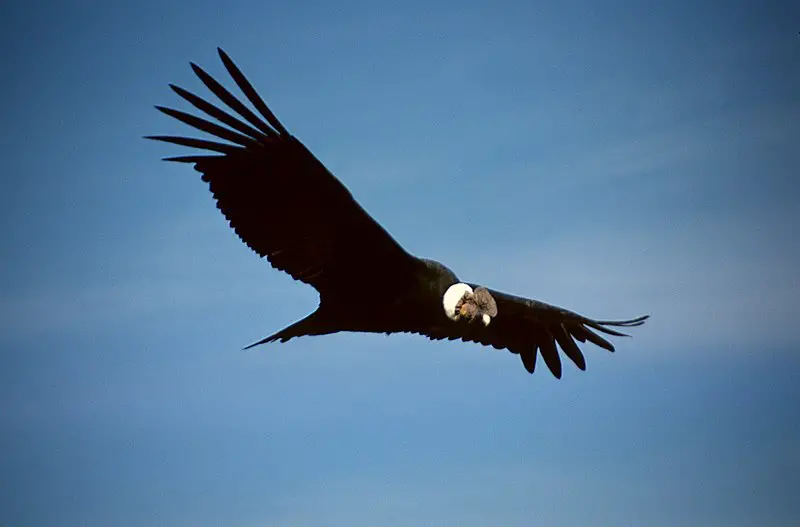
The Andean condor is a giant South American Cathartid vulture and the only member of its genus.
Found in the Andes mountains and along Pacific coasts, it is thought to be the largest flying bird on Earth by weight and wingspan with a maximum wingspan reaching up to 10 feet 10 inches (3.3 m) and weighing 33 lbs (15 kg).
It has mainly black plumage which helps keep it warm at high altitudes, while white patches adorn its head, neck, chest as well as underwing coverts.
Its powerful bill allows it to consume carrion efficiently while also being able to crack bones for nutrition when necessary.
The amazing flight capabilities of this majestic creature allow them soar through air thermals effortlessly; making them an impressive sight against clear blue skies.
Scientific classification:
| Kingdom | Animalia |
| Phylum | Chordata |
| Class | Aves |
| Order | Accipitriformes |
| Family | Cathartidae |
| Genus | Vultur Linnaeus, 1758 |
| Species | V. gryphus |
2. Austral Pygmy Owl
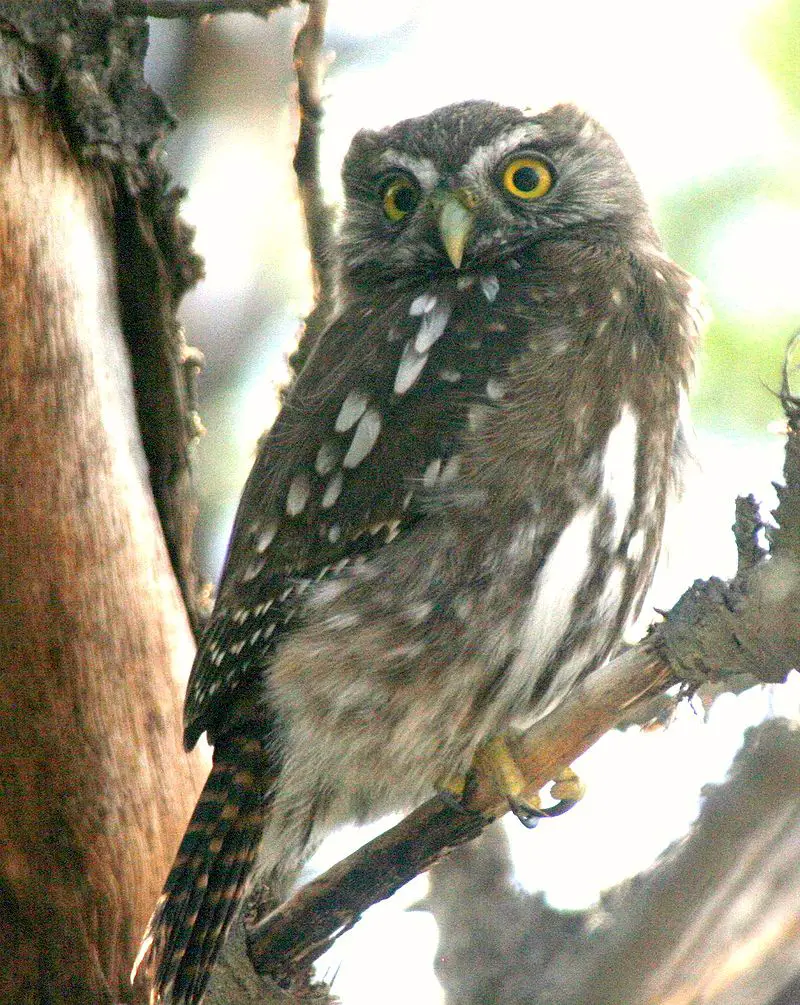
The Austral Pygmy Owl is a species of owl that resides in Argentina and Chile. It has sometimes been mistaken as a subspecies of Ferruginous Pygmy Owl, but DNA studies have proven it to be its own unique species.
Measuring up to 21 cm in length, the Austral Pygmy Owl has distinctive reddish-brown feathers with white spotting on its wings and tail.
Its eyes are bright yellow while its facial disc is striped brown or grey depending on the individual bird’s colouration patterning.
This small nocturnal hunter preys mostly on insects such as grasshoppers, crickets, moths and beetles which can often be found in open habitats like grasslands fields near water sources such as lakes or rivers where they also nest among trees for protection from predators during daylight hours.
The Austral Pygmy Owls are an important part of their local ecosystems providing insect control without harming other wildlife populations which makes them vital members of their environment.
Scientific classification:
| Kingdom | Animalia |
| Phylum | Chordata |
| Class | Aves |
| Order | Strigiformes |
| Family | Strigidae |
| Genus | Glaucidium |
| Species | G. nana |
Also Featured In: Patagonia Birds You Should Know, Common Birds that Live around Ushuaia
3. Burrowing Parrot
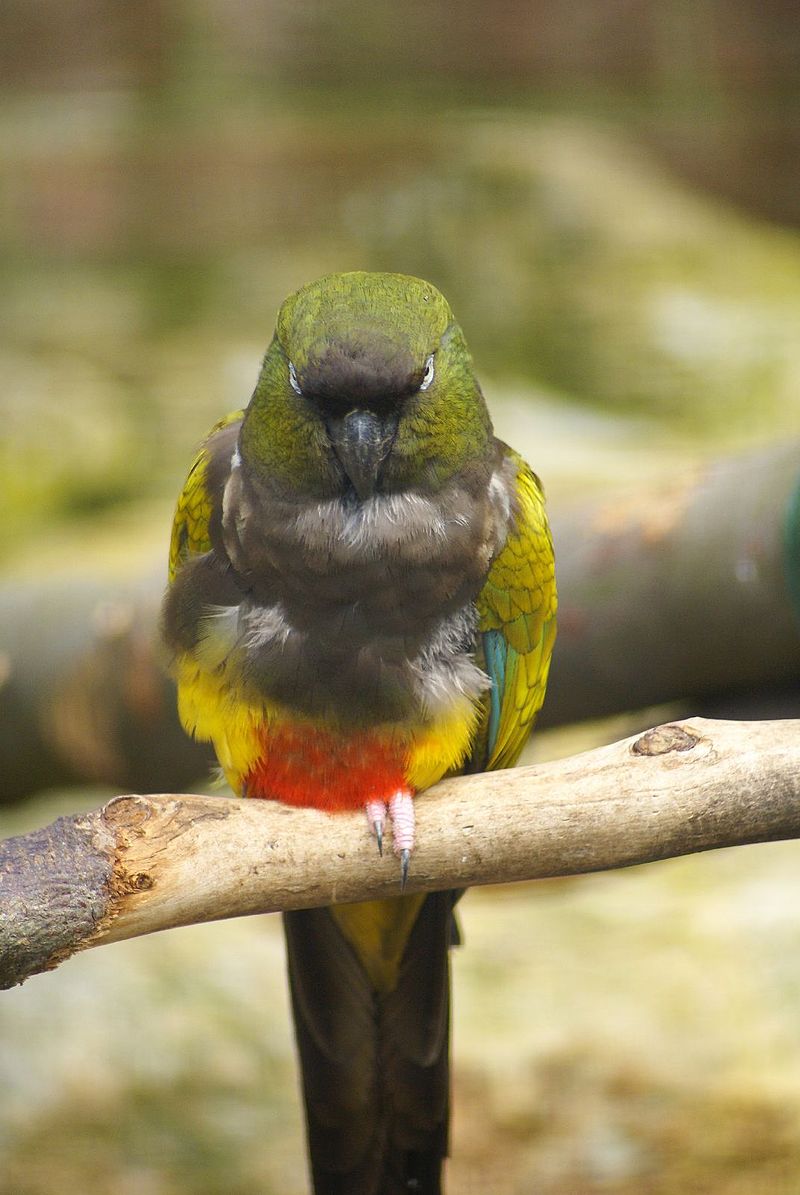
The Burrowing Parrot is a species of parrot native to Argentina and Chile belonging to the monotypic genus Cyanoliseus.
It has four subspecies with distinctive characteristics such as white eye rings, white breast markings, olive green body colour and brightly coloured beaks..
The adults reach a length up to 38 cm (15 in) from head to tail making them one of the larger members of their family.
They are ground-dwelling birds who nest in burrows or cavities on cliff faces. Their diet consists mainly of seeds but also includes fruit, flowers and buds that they forage daily for food.
With its bright plumage, it’s easy to see why these birds have become popular pets around the world.
Scientific classification:
| Kingdom | Animalia |
| Phylum | Chordata |
| Class | Aves |
| Order | Psittaciformes |
| Family | Psittacidae |
| Genus | Cyanoliseus |
| Species | C. patagonus |
4. Magellanic Woodpecker
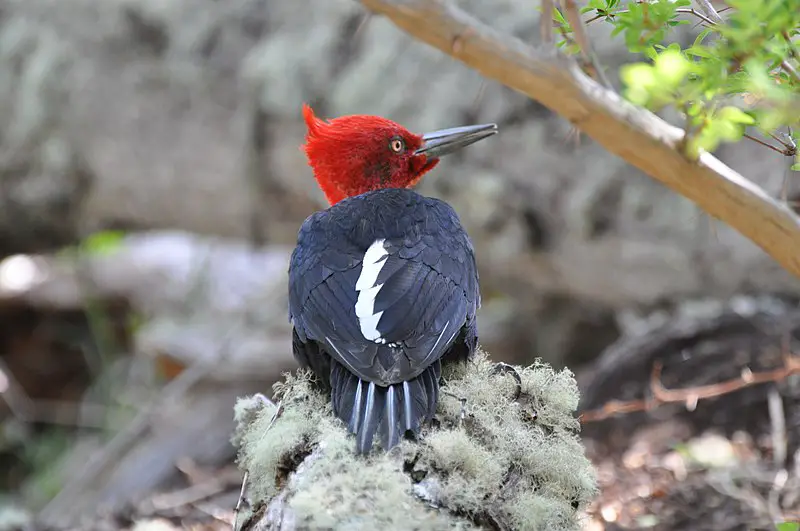
The Magellanic woodpecker is a large species of bird found in the southern regions of Chile and Argentina. It is part of the Campephilus genus, which includes iconic birds such as ivory-billed woodpeckers.
This species can grow to be up to 45 cm (18 inches) long, with males weighing an average of 320 grams (11 ounces). Its plumage consists mostly of black feathers on its head, wings and backside; it has white markings covering its belly area.
The most distinct feature about this bird is its red crest that runs from behind their bill down over their neck and shoulders – hence giving them their name ‘Magellanic’.
These beautiful creatures are known for making loud drumming noises as they search for food like beetles, ants or other insects in tree trunks or branches.
They inhabit dense forests areas where they can find plenty to eat while avoiding being preyed upon by predators.
Scientific classification:
| Kingdom | Animalia |
| Phylum | Chordata |
| Class | Aves |
| Order | Piciformes |
| Family | Picidae |
| Genus | Campephilus |
| Species | C. magellanicus |
5. Darwin’s Rhea
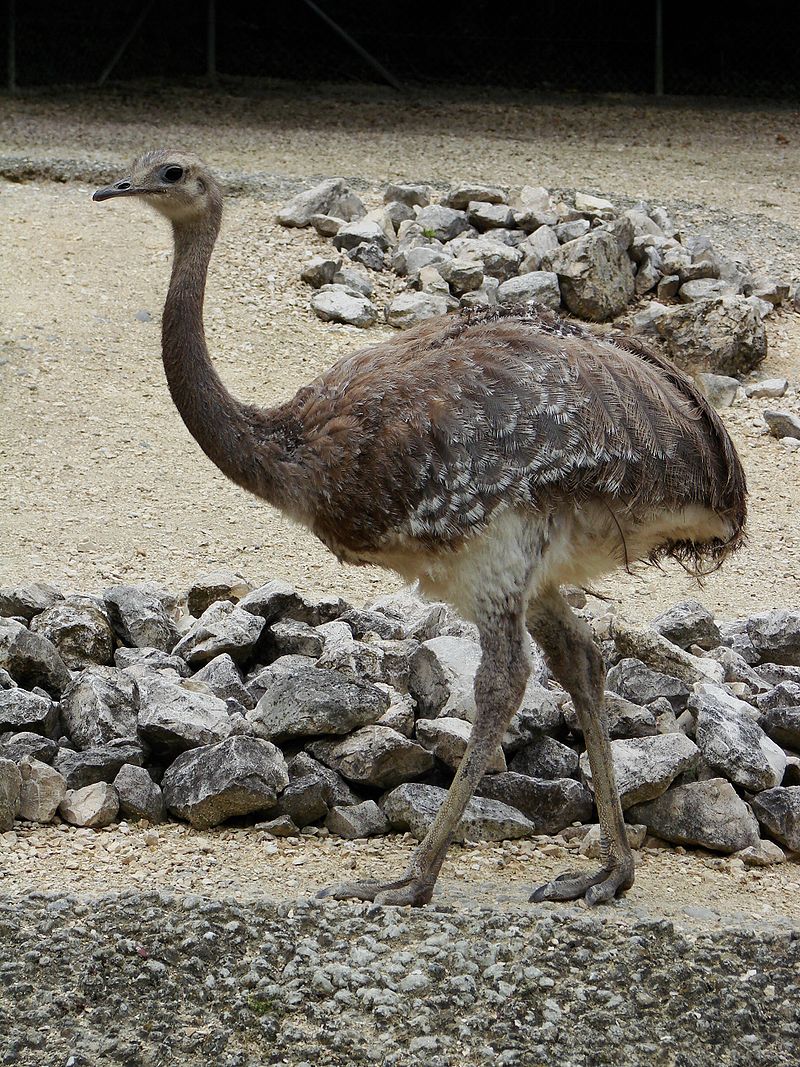
Darwin’s rhea is a flightless bird, the smaller of two extant species of rheas. It stands at 35 to 39 inches tall and has an average length of 36-39 inches with a weight range between 33 – 63 lbs.
The head and bill are both quite small in size compared to other ratites.
This large bird can be found across Altiplano and Patagonia regions in South America where it feeds on plants such as grasses, herbs, roots, bark, fruits etc., while also occasionally consuming insects and lizards.
Most notably they use their powerful legs for running away from predators like foxes or pumas who may attempt to hunt them down due to its slow speed when taking off or flying away isn’t possible.
Scientific classification:
| Kingdom | Animalia |
| Phylum | Chordata |
| Class | Aves |
| Infraclass | Palaeognathae |
| Order | Rheiformes |
| Family | Rheidae |
| Genus | Rhea |
| Species | R. pennata |
6. Slender-Billed Parakeet
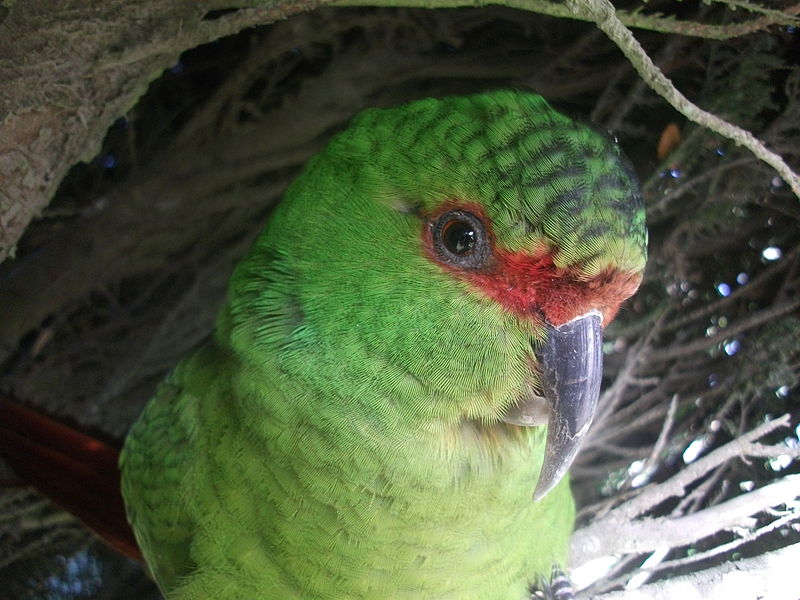
The Slender-billed Parakeet is a medium size South American parrot that belongs to the long-tailed Arinae family. It’s found in temperate forests, mainly throughout southern Chile and parts of central Chile.
Its local common name is Choroy and it has an unmistakable slender bill with bright red feathers around the eyes, yellowish beige on its backside, green wings and blue tail tips. The bird eats mostly fruits but also feeds on nectar from flowers or small insects for protein sources.
In addition to being active during the day they can often be seen flying in large flocks at dusk making loud chirping sounds as if communicating amongst each other.
They are known to nest high up in trees creating communal roosts which help protect them from predators like hawks or snakes while they sleep at night together as a flock providing warmth against cold temperatures during winter months when food becomes scarce due to lack of blooming plants.
Scientific classification:
| Kingdom | Animalia |
| Phylum | Chordata |
| Class | Aves |
| Order | Psittaciformes |
| Family | Psittacidae |
| Genus | Enicognathus |
| Species | E. leptorhynchus |
7. Chilean Flamingo
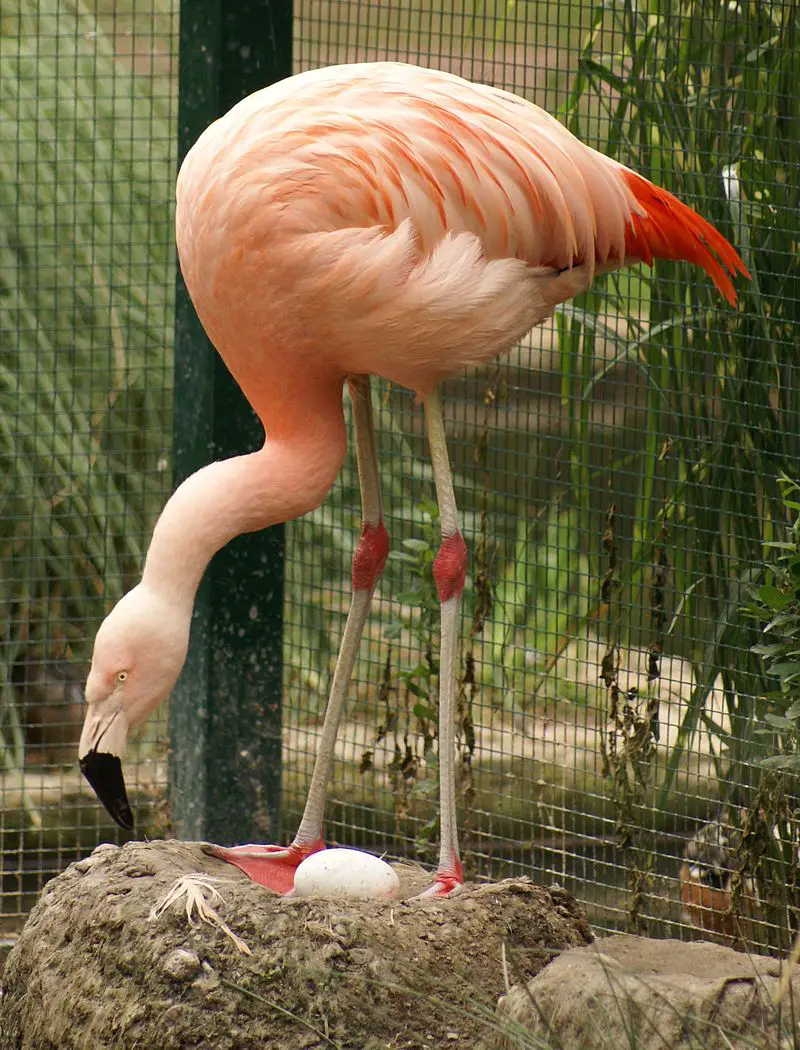
The Chilean Flamingo is a large bird native to South America, ranging from Ecuador and Peru to Chile and Argentina. It is an impressive species of flamingo which stands at 43-51 inches tall.
With its distinctive long neck, bright pink feathers, and black tipped wings – it truly is a sight to behold.
Unfortunately the population of this majestic creature has been decreasing over time due to human activities such as hunting for their meat or eggs.
The IUCN currently lists them as near threatened – meaning we need to act now if we want future generations get the chance experience these beautiful birds in person.
We must be more responsible with our actions so that these iconic animals can live peacefully without fear of harm from humans.
Scientific classification:
| Kingdom | Animalia |
| Phylum | Chordata |
| Class | Aves |
| Order | Phoenicopteriformes |
| Family | Phoenicopteridae |
| Genus | Phoenicopterus |
| Species | P. chilensis |
8. Chilean Seaside Cinclodes
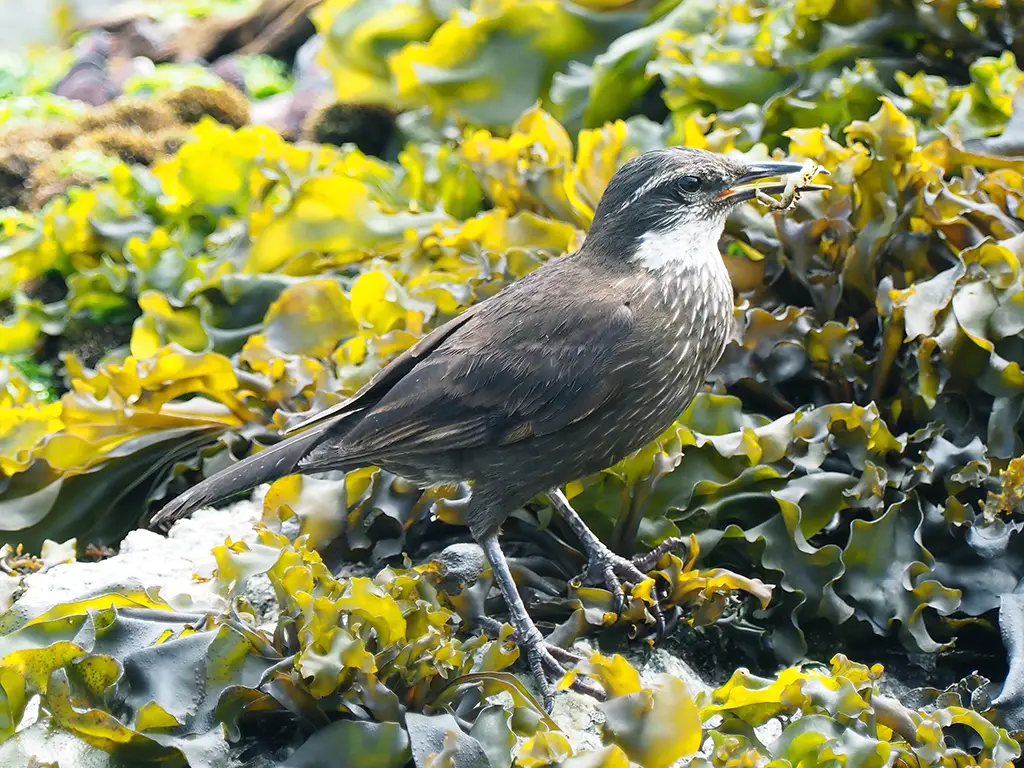
The Chilean seaside cinclodes is a species of bird in the family Furnariidae endemic to Chile. It has an average length of 27 cm and its upper parts are mainly greyish-brown with black streaks, while its underside is white or pale grey.
The head is brown with darker stripes around it and some yellow on the throat area. Its bill is long, slender and curved downwards at the tip.
This bird inhabits rocky shorelines along the coast where they feed mostly on small crustaceans such as barnacles, limpets or mussels which they find by probing through crevices between rocks using their beaks..
They also consume insects from time to time depending upon availability in that particular region. These birds usually nest under boulders near water bodies during breeding season before migrating inland for feeding purposes later on during winter months.
Scientific classification:
| Kingdom | Animalia |
| Phylum | Chordata |
| Class | Aves |
| Order | Passeriformes |
| Family | Furnariidae |
| Genus | Cinclodes |
| Species | C. nigrofumosus |
9. Humboldt Penguin
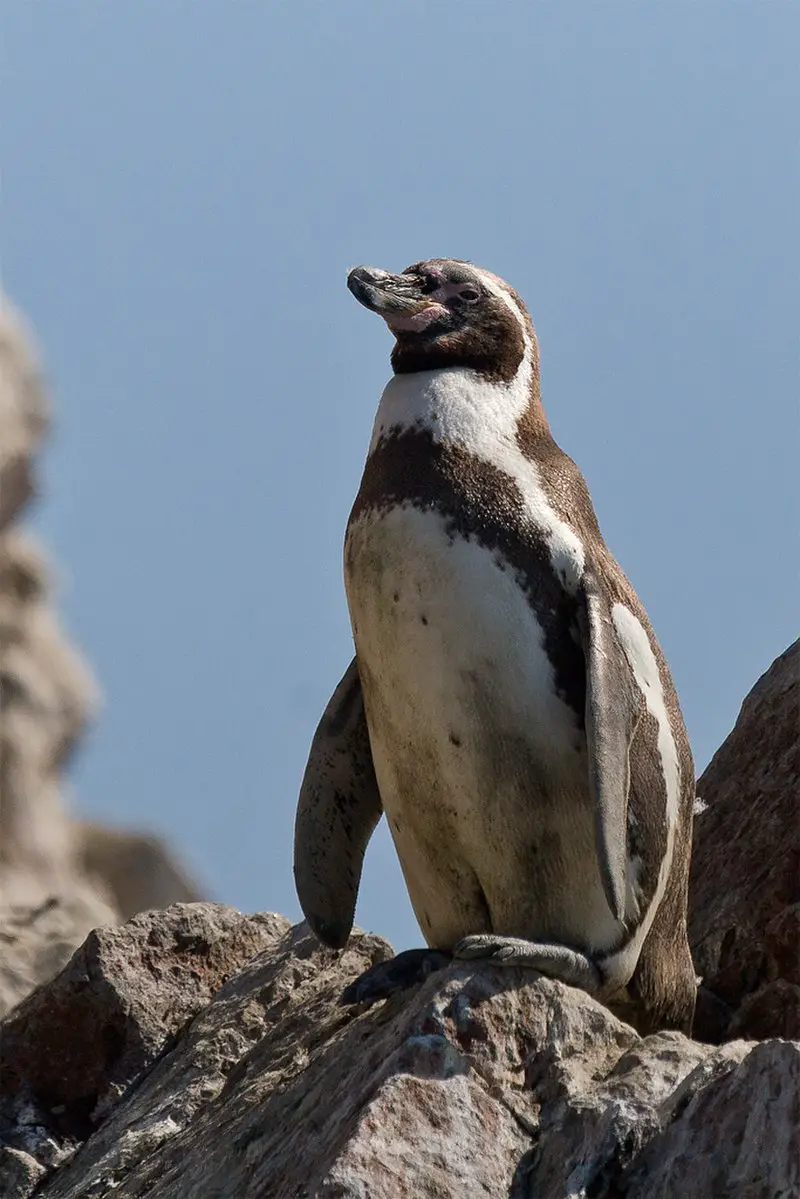
The Humboldt Penguin is a medium-sized bird that resides in South America, mainly along the coastal regions of Peru. It belongs to the same family as African Penguins, Magellanic Penguins and Galapagos Penguins.
The species was named after Alexander von Humboldt, an explorer who first discovered it during his travels. With its black and white plumage, they are easily recognizable by their distinctive pink tufts on their face and feet.
Despite being listed as vulnerable due to habitat loss and hunting for food or feathers, these penguins have adapted well with human presence around them; making colonies close to fishing villages near rocky coasts where there is abundant shelter from predators like sea lions and seals.
They feed primarily on anchovies but also eat other fish such as sardines if available nearby.
Conservation efforts must be taken soon so we can protect this unique creature from extinction.
Scientific classification:
| Kingdom | Animalia |
| Phylum | Chordata |
| Class | Aves |
| Order | Sphenisciformes |
| Family | Spheniscidae |
| Genus | Spheniscus |
| Species | S. humboldti |
10. Juan Fernández Firecrown
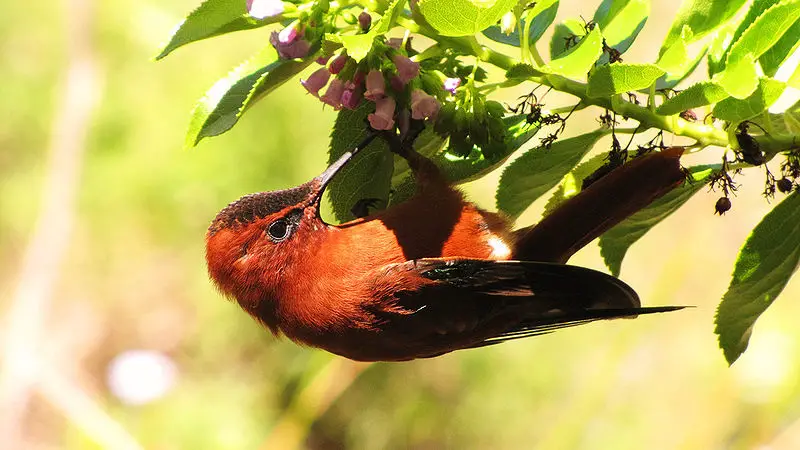
The Juan Fernández firecrown is a critically endangered hummingbird belonging to the tribe Lesbiini and subfamily Lesbiinae. It can only be found on Isla Róbinson Crusoe, one of three islands in the Chilean archipelago known as Juan Fernandez.
This species shares its genus Sephanoides with another bird called green-backed firecrown. The sole existing subspecies has an eye-catching red crown that gives it its name – “firecrown”. Due to deforestation from human activity and competition for food sources, this rare bird faces an uncertain future and may soon become extinct without conservation efforts being made now.
Scientific classification:
| Kingdom | Animalia |
| Phylum | Chordata |
| Class | Aves |
| Order | Apodiformes |
| Family | Trochilidae |
| Genus | Sephanoides |
| Species | S. fernandensis |
11. Magellanic Penguin
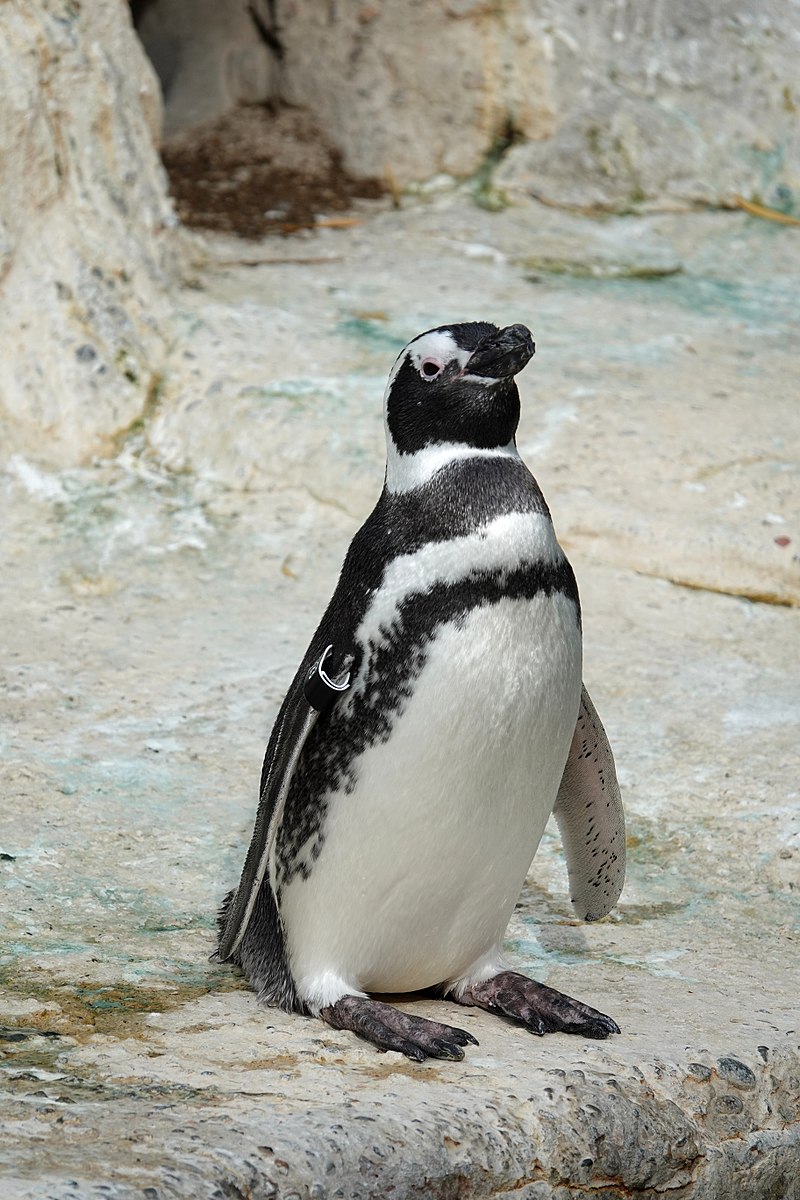
The Magellanic penguin is a beloved South American bird that breeds in coastal Patagonia, including Argentina, Chile and the Falkland Islands. It migrates to Brazil and Uruguay occasionally as far north as Espirito Santo.
Vagrants have even been spotted in El Salvador, Antarctica’s Avian Island and Australia/New Zealand.
This species of penguin is perhaps most recognizable for its striking black-and-white plumage – it has an entirely white underbelly with two distinctive stripes across its back which are black above and white below.
Additionally, they possess large pinkish feet which act like paddles when swimming underwater; these birds can swim up to 20 mph.
The Magellanic Penguin typically lives around 15 years but some may live longer due to their strong social bonds within colonies.
All in all this majestic creature makes quite the statement both on land or sea – making them a unique addition our planet’s wildlife population.
Scientific classification:
| Kingdom | Animalia |
| Phylum | Chordata |
| Class | Aves |
| Order | Sphenisciformes |
| Family | Spheniscidae |
| Genus | Spheniscus |
| Species | S. magellanicus |
12. Black-Necked Swan
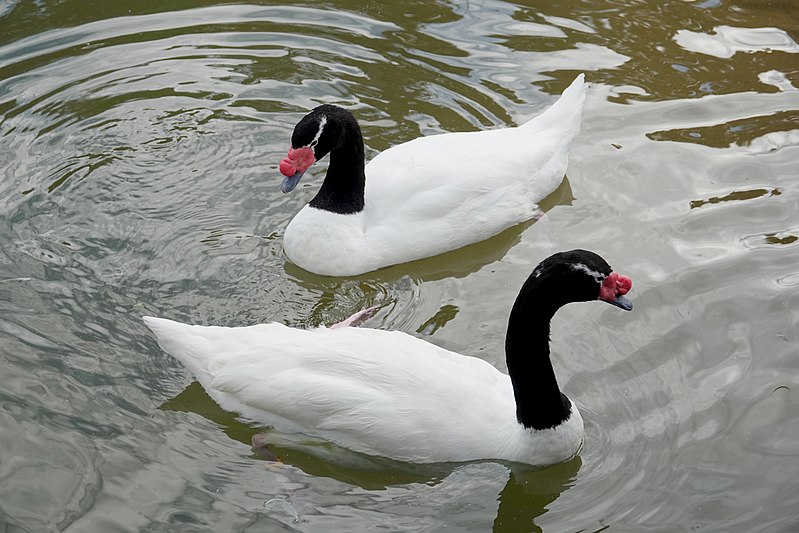
The Black-necked Swan is a species of waterfowl belonging to the Cygnini tribe in subfamily Anserinae. They are native to Argentina, Brazil, Chile, Uruguay and the Falkland Islands.
The black-necked swan has been known to stand out from other members of its family due to its unique appearance; it has an all white body with a black neck and head.
This bird typically lives near freshwater bodies such as lakes or rivers but can also be found on ocean coasts during some seasons when food sources become scarce.
It mainly feeds on algae and aquatic plants though occasionally eats small fish too for extra nutrition.
Overall this gorgeous bird stands proud amongst many others because of their stunning colour combination which makes them unmistakable.
Scientific classification:
| Kingdom | Animalia |
| Phylum | Chordata |
| Class | Aves |
| Order | Anseriformes |
| Family | Anatidae |
| Genus | Cygnus |
| Species | C. melancoryphus |
13. Moustached Turca
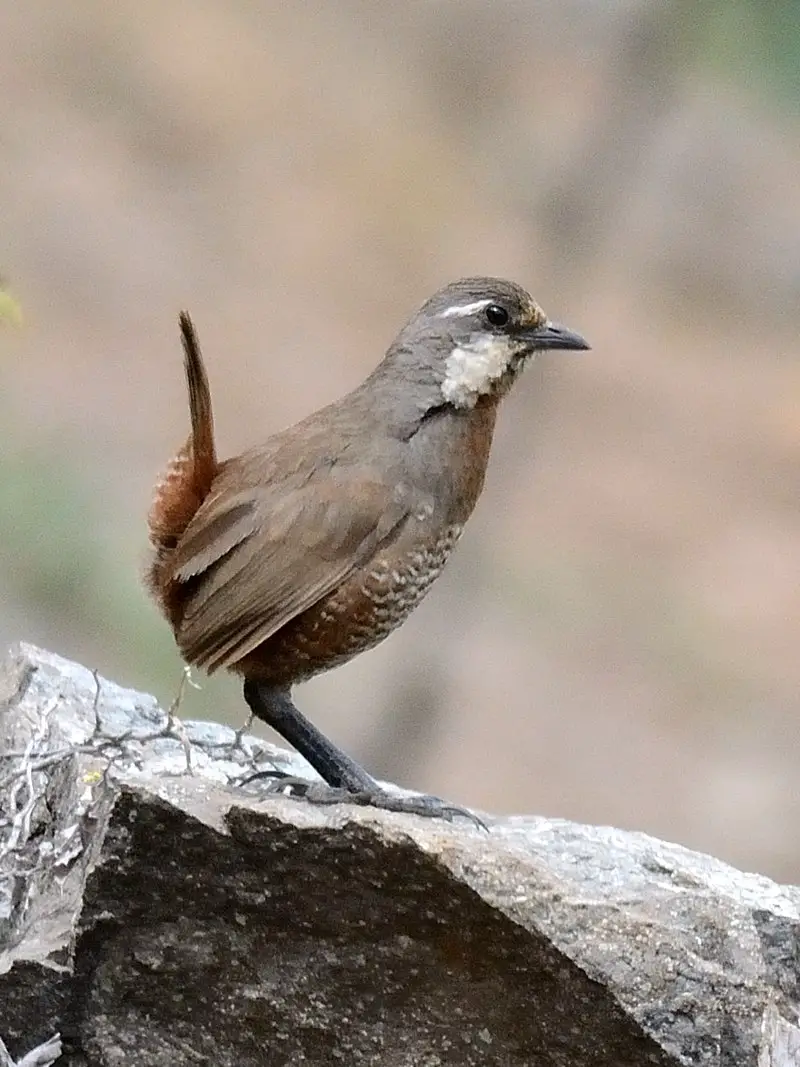
The Moustached Turca is a stout passerine bird found only in Chile. It stands at 23-24 cm tall and has a large bill, strong legs and feet, as well as an often cocked tail.
Its plumage mainly consists of brown colouring with white barring on the breast, belly, and underneath its wings. This species belongs to the Tapaculo group within its genus Pteroptochos along with two other species known as Huet-huet birds.
As it’s endemic to Chile this makes this moustached turca even more special due to it being restricted solely to that area where its conservation status currently remains unknown making further research essential for future protection initiatives.
Scientific classification:
| Kingdom | Animalia |
| Phylum | Chordata |
| Class | Aves |
| Order | Passeriformes |
| Family | Rhinocryptidae |
| Genus | Pteroptochos |
| Species | P. megapodius |
14. Chilean Tinamou
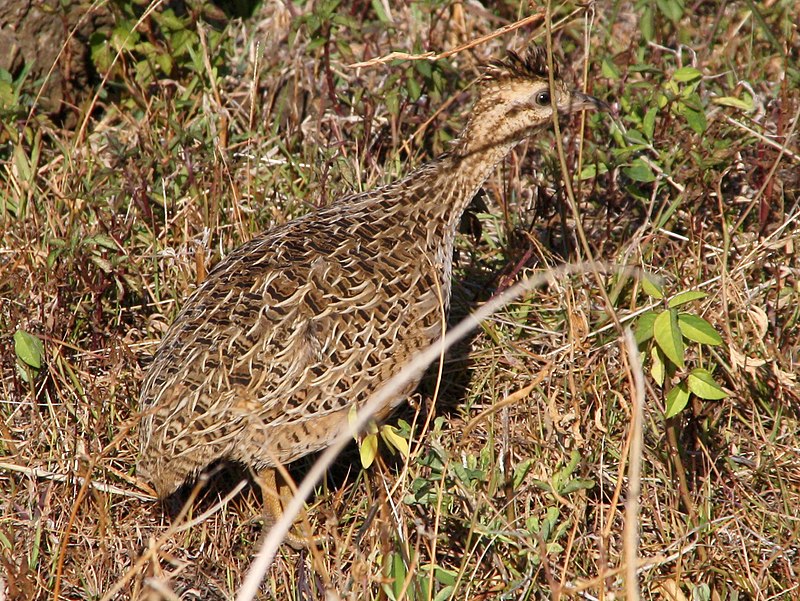
The Chilean tinamou is a type of bird typically found in high altitude shrubland in central Chile. It belongs to the family Tinamidae and are part of the ratites group, which evolved from prehistoric flying birds.
Although they can fly, it isn’t very strong flight compared with other birds. They have short wings and legs that make them well-adapted for their habitat. The plumage color varies depending on season or region but usually has brown mottled streaks on its back while its face is greyish white with black stripes along each side of neck and eyes having yellow irises.
Its diet consists mainly of fruits, seeds, insects and small invertebrates like snails or worms as well as some leaves or buds when available during winter months.
Scientific classification:
| Kingdom | Animalia |
| Phylum | Chordata |
| Class | Aves |
| Infraclass | Palaeognathae |
| Order | Tinamiformes |
| Family | Tinamidae |
| Genus | Nothoprocta |
| Species | N. perdicaria |
Also Featured In: Easter Island Birds You Should Know,
15. Greater Flamingos
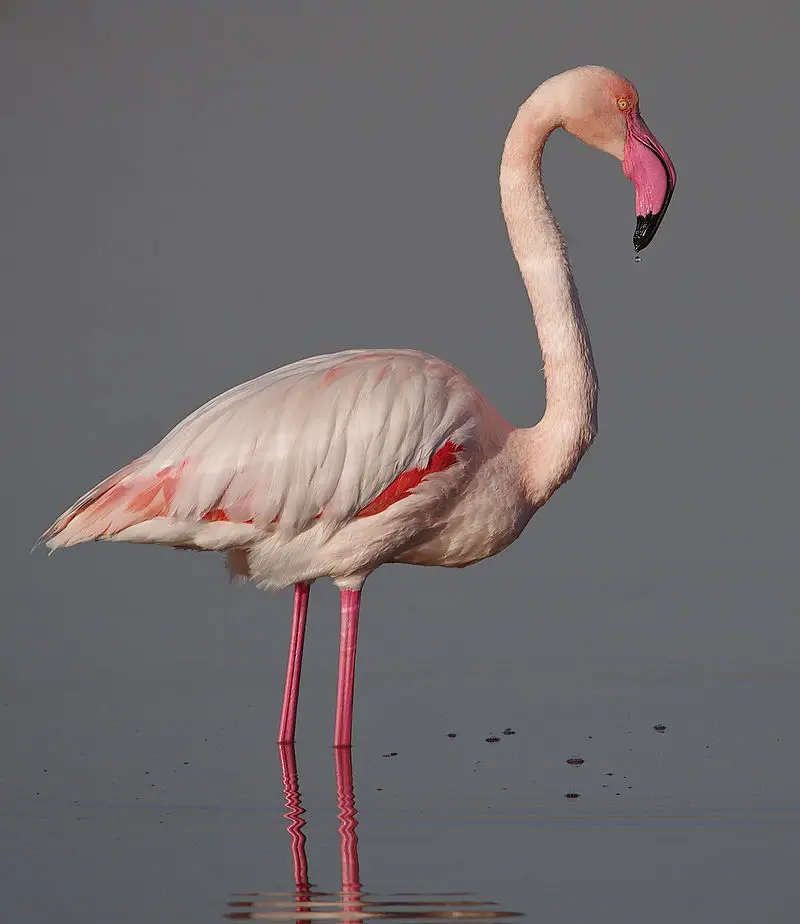
The Greater Flamingo (Phoenicopterus ruber) is the most widespread species of flamingos and can be found in parts of Europe, Africa, Asia and South America.
It has an unmistakable bright pink plumage that stands out against its white feathers. Its long legs are also a distinguishing feature as they reach up to 46 inches long.
The bill is curved downwards with a black tip at the end, which makes it easy for them to filter food from water sources like lakes or lagoons.
This diet mainly consists of small shrimp-like crustaceans called brine shrimp along with other aquatic insects and plants.
They also have salt glands on their tongues that help remove excess salt from ocean waters when they drink seawater as part of their regular diet.
Scientific classification:
| Kingdom | Animalia |
| Phylum | Chordata |
| Class | Aves |
| Order | Phoenicopteriformes |
| Family | Phoenicopteridae |
| Genus | Phoenicopterus Linnaeus, 1758 |
Also Featured In: Flocks Birds around Us, Savanna Birds You Need to See
16. Chilean Pigeon
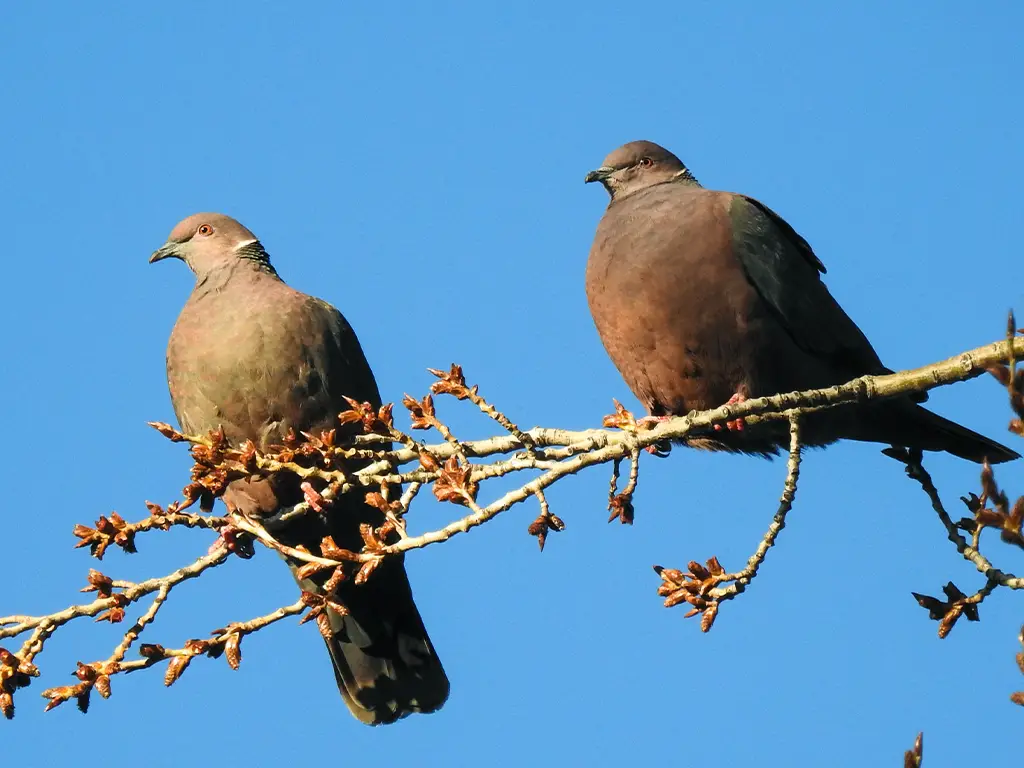
The Chilean pigeon is a species of bird found living in Chile and Argentina. It has no subspecies and may form a superspecies with the ring-tailed pigeon and band-tailed pigeon.
This medium sized bird typically measures 35 to 37 cm long, weighing 220 to 340 g. The adult male’s plumage is mostly greyish brown with paler fringes on its wings while the female tends to be lighter in colouration overall.
They have short tails which are squared off at the tips, along with yellow eyes and legs that appear orange/reddish due to their feathers’ pigmentation being quite transparent over them.
These birds inhabit areas such as woodlands, farmlands or open country where they feed mainly on fruits like berries or seeds from grasses or cereals; sometimes also supplementing this diet by taking small insects too.
Scientific classification:
| Kingdom | Animalia |
| Phylum | Chordata |
| Class | Aves |
| Order | Columbiformes |
| Family | Columbidae |
| Genus | Patagioenas |
| Species | P. araucana |
17. Chilean Flicker
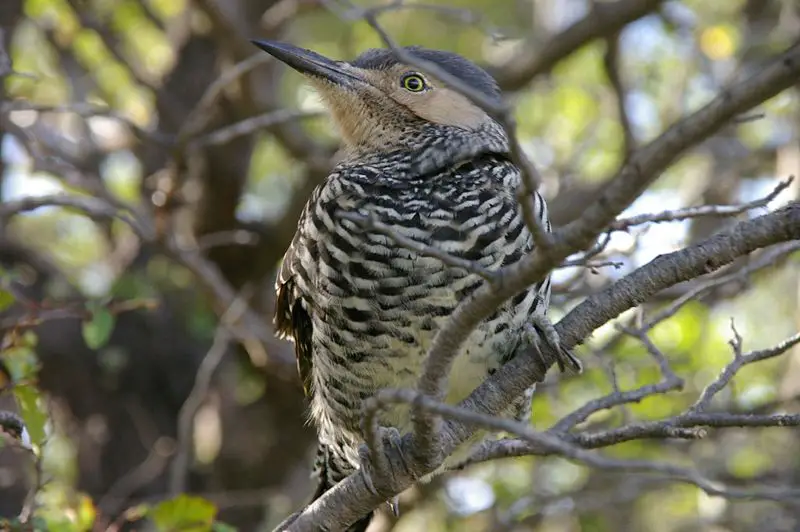
The Chilean flicker is a species of bird found in Argentina and Chile, belonging to the family Picidae. It inhabits temperate forests, subtropical or tropical high-altitude shrubland as well as heavily degraded former forest areas such as Araucanía in Chile.
The flicker has beautiful plumage with mottled brown upperparts and barred flight feathers on its wings which are easily visible while it flies. Its underparts range from yellowish white to buffy orange colouration depending upon age and sex of the individual bird.
This birds feeds mainly on insects but will also consume fruits when available during certain times of year. All in all this colourful and unique species adds beauty to many parts South America’s landscape.
Scientific classification:
| Kingdom | Animalia |
| Phylum | Chordata |
| Class | Aves |
| Order | Piciformes |
| Family | Picidae |
| Genus | Colaptes |
| Species | C. pitius |
18. Red-Gartered Coot
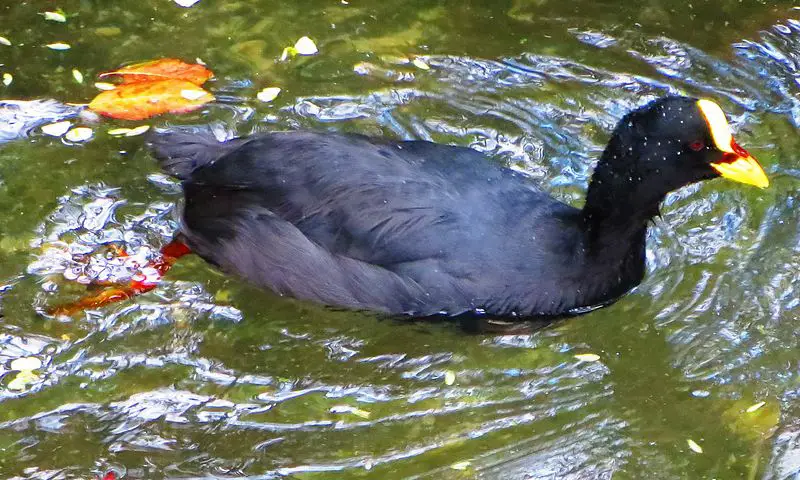
The Red-gartered Coot is a species of rail found in Argentina, Brazil, Chile, Paraguay and Uruguay. It’s about 17 to 20 inches long with both sexes looking the same.
They have a yellow bill along with a frontal shield that has an eye catching patch of red between it and its forehead. The wings are blackish brown while the tail feathers are dirty white or grayish color on top and reddish underneath.
Their legs also feature bright red garters just above their toes which gives them its name – Red-Gartered Coot. These birds inhabit wetlands where they feed mainly on plants such as grasses and sedges but may take some invertebrates too when available.
Despite being of least concern according to IUCN they face threats from habitat destruction due to human activities like farming practices so conservation efforts need be taken for these beautiful creatures.
Scientific classification:
| Kingdom | Animalia |
| Phylum | Chordata |
| Class | Aves |
| Order | Gruiformes |
| Family | Rallidae |
| Genus | Fulica |
| Species | F. armillata |
Also Featured In: Birds That Live In Tristan da Cunha,
19. Black Skimmer
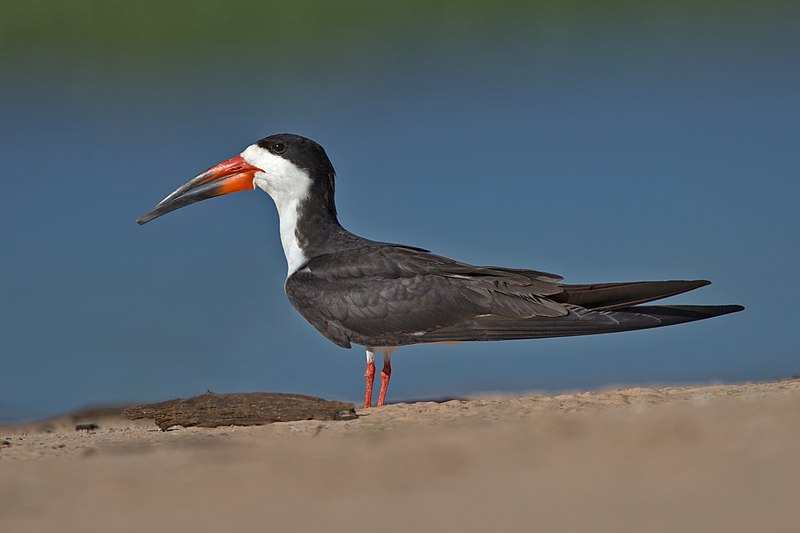
The Black Skimmer is a seabird which belongs to the skimmer genus Rynchops and Laridae family.
It breeds in North and South America, while Northern populations migrate south for winter towards warmer climates such as the Caribbean or Pacific coasts.
The Southern American races have adapted to annual floods by making shorter migrations during this time.
These birds are easily identified with their unique long red bill that has an upper mandible longer than its lower mandible.
They feed mainly on small fish caught at night when they skim across shallow water using their beak like a knife cutting through waves of water.
Their dark grey back contrasts against white belly feathers creating beautiful patterns in flight, aiding them in catching prey easier due to its camoflauge effect above and below waters surface.
Scientific classification:
| Kingdom | Animalia |
| Phylum | Chordata |
| Class | Aves |
| Order | Charadriiformes |
| Family | Laridae |
| Genus | Rynchops |
| Species | R. niger |
20. Picui Ground Dove
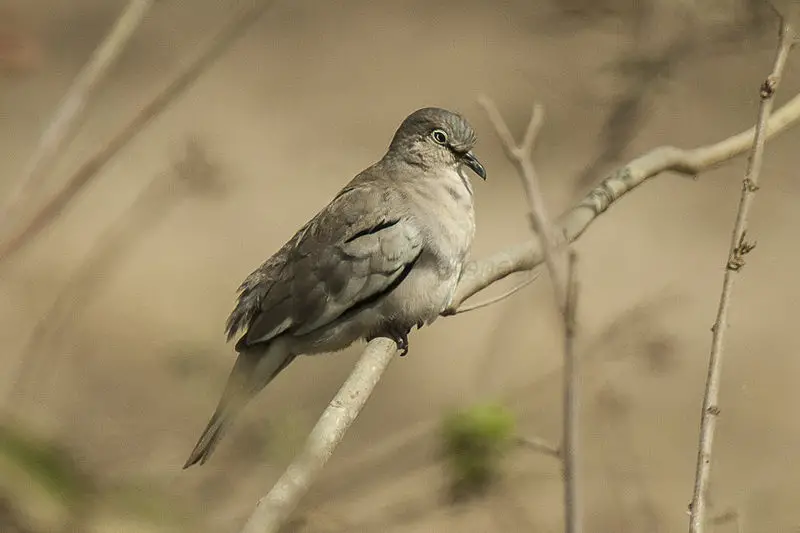
The Picui Ground Dove is a species of bird found primarily in South America. It has two subspecies, the nominate C. p. picui and C. p. strepitans, which can be found in Argentina, Bolivia, Brazil, Chile, Colombia Paraguay Peru and Uruguay.
This small dove prefers to inhabit open woodland areas with dense undergrowth or scrub vegetation near water sources such as ponds or streams where it feeds on seeds and other plant matter available nearby while croaking calls are uttered by both sexes during breeding season that typically commences at the start of rainy season from December-March depending upon its location within range territory.
The Picui Ground Dove is often considered a sister species to the Croaking Ground Dove (Columbina cruziana) due to their similar characteristics including plumage colouration but also behavioural traits such as foraging habits throughout their respective ranges across South America.
Scientific classification:
| Kingdom | Animalia |
| Phylum | Chordata |
| Class | Aves |
| Order | Columbiformes |
| Family | Columbidae |
| Genus | Columbina |
| Species | C. picui |
21. Eared Dove
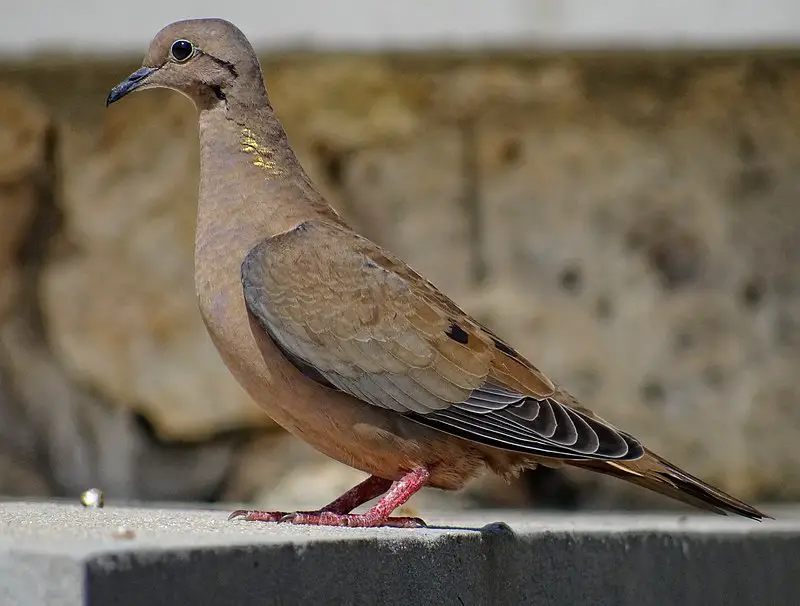
The Eared Dove is a beautiful bird that can be found throughout South America, ranging from Colombia to Argentina and Chile. It has also been spotted in Trinidad and Tobago recently.
This species tends to be partially migratory depending on food supplies available in the area, making it an important part of the local environment.
Its plumage tends to vary by region with some individuals having brighter colors than others where they are found near forested areas or along coasts.
The most recognizable feature of this dove is its ear tufts which gives it its common name – Eared Dove.
These doves have a soft cooing sound as their call which makes them truly unique among other birds in their range.
Scientific classification:
| Kingdom | Animalia |
| Phylum | Chordata |
| Class | Aves |
| Order | Columbiformes |
| Family | Columbidae |
| Genus | Zenaida |
| Species | Z. auriculata |
22. Austral Parakeet
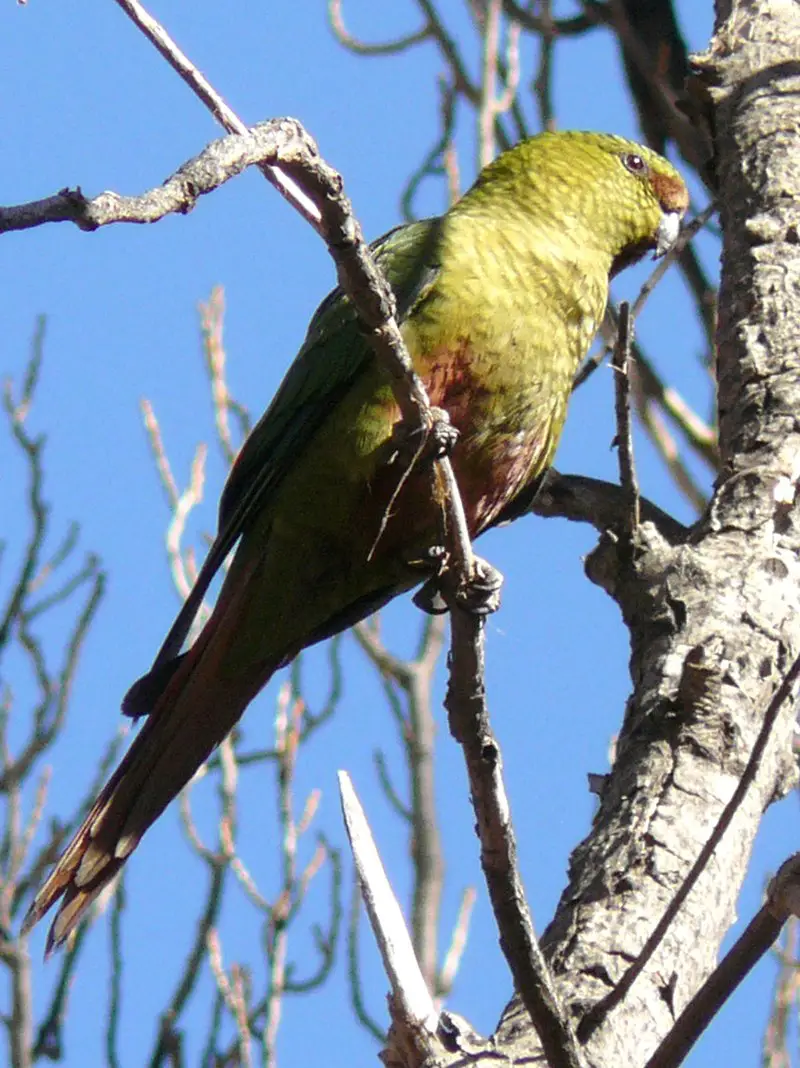
The Austral Parakeet, also known as the Emerald Parakeet or Austral Conure, is a beautiful bird native to South America. It has vibrant green plumage with light barring and some dull red on the forehead and lores.
This species can reach up to 35 cm in length – 2 cm larger than monk or quaker parakeets. Its range stretches from Argentina and Chile all the way north to Temuco.
These birds are highly social animals that live together in flocks of varying sizes depending on availability of food sources.
They feed mainly on seeds but will also consume fruit, berries and insects when available.
The Austral Parakeet is an intelligent species that bonds closely with its human keepers if provided enough enrichment activities like foraging toys and playtime outside their cage environment.
Scientific classification:
| Kingdom | Animalia |
| Phylum | Chordata |
| Class | Aves |
| Order | Psittaciformes |
| Family | Psittacidae |
| Genus | Enicognathus |
| Species | E. ferrugineus |
23. Austral Rail
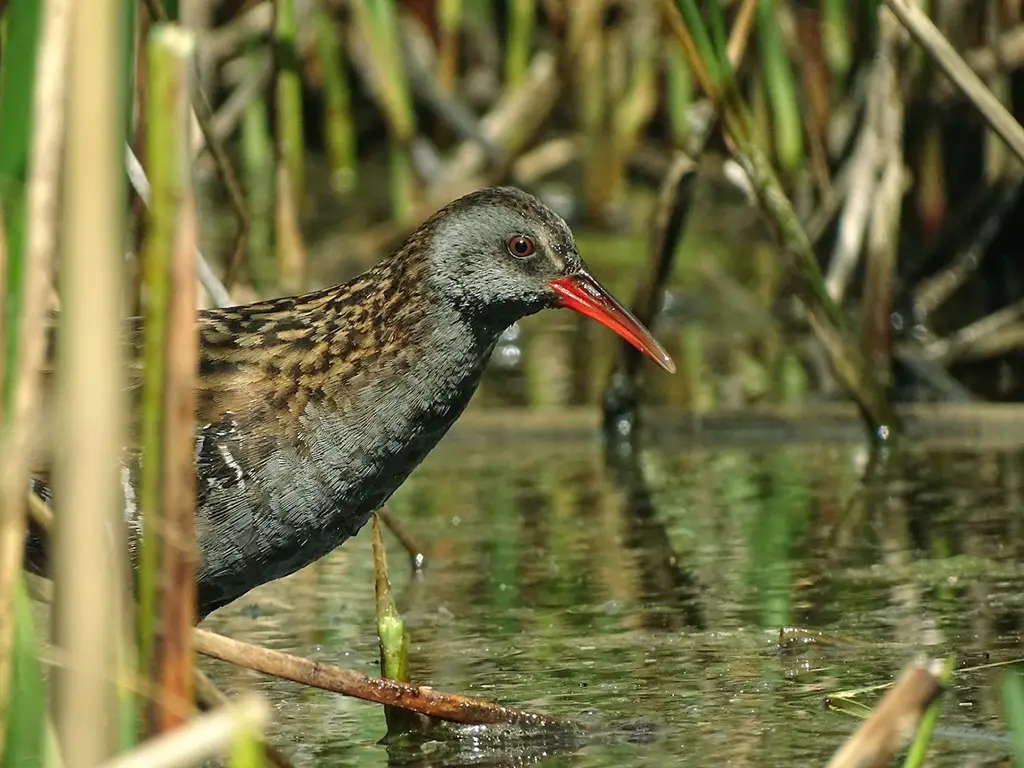
The Austral Rail is a vulnerable species of bird found primarily in Argentina and Chile. It belongs to the Rallinae subfamily of the family Rallidae, which includes rails, gallinules and coots.
While some have suggested that it be classified as conspecific with Virginia Rails (R. limicola), this has not been widely accepted by experts.
The austral rail is monotypic; there are no other known species within its genus or family that share similar physical characteristics or behaviors.
Its diet consists mostly of small insects such as grasshoppers, crickets, caddisflies and mayflies supplemented occasionally with vegetation like seeds and leaves during winter months when insect sources become scarce.
Conservation efforts must continue if we wish to keep this unique creature safe from extinction.
Scientific classification:
| Kingdom | Animalia |
| Phylum | Chordata |
| Class | Aves |
| Order | Gruiformes |
| Family | Rallidae |
| Genus | Rallus |
| Species | R. antarcticus |
24. White-Throated Tapaculo
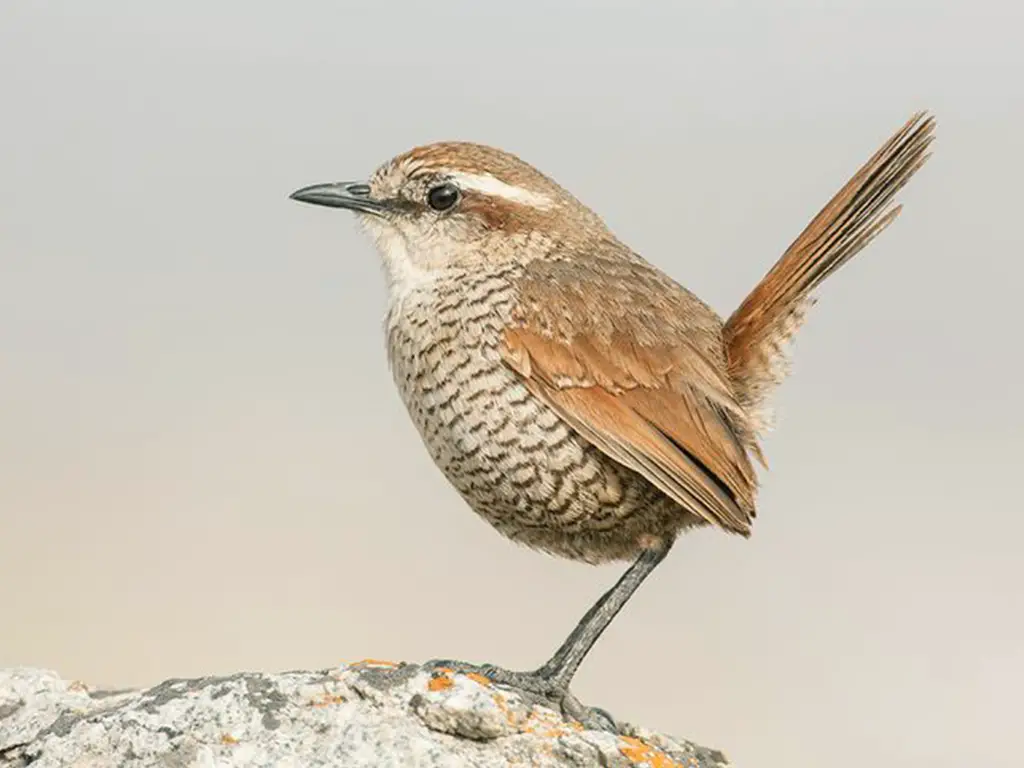
The White-throated Tapaculo is a species of bird that’s found only in Chile. It has two subspecies, the nominate Scelorchilus albicollis albicollis and S.a.
atacamae, both described by Kittlitz in 1830 and Carl Eduard Hellmayr respectively. This ground dwelling species prefers to inhabit dense vegetation areas near streams or rivers for protection from predators.
The adult of the nominate subspecies have grey upperparts with white underparts while S .a .atacamae have brownish coloured plumage instead of gray with some rufous feathers on its wings & tail area marking it as distinct from other tapaculos present in the region..
They feed mostly on insects but can also consume small fruits like berries when available . Their song consists mainly of short phrases ending high pitched notes which are often repeated multiple times during courtship display season making them quite vocal birds overall.
Scientific classification:
| Kingdom | Animalia |
| Phylum | Chordata |
| Class | Aves |
| Order | Passeriformes |
| Family | Rhinocryptidae |
| Genus | Scelorchilus |
| Species | S. albicollis |
25. Hudsonian Godwit
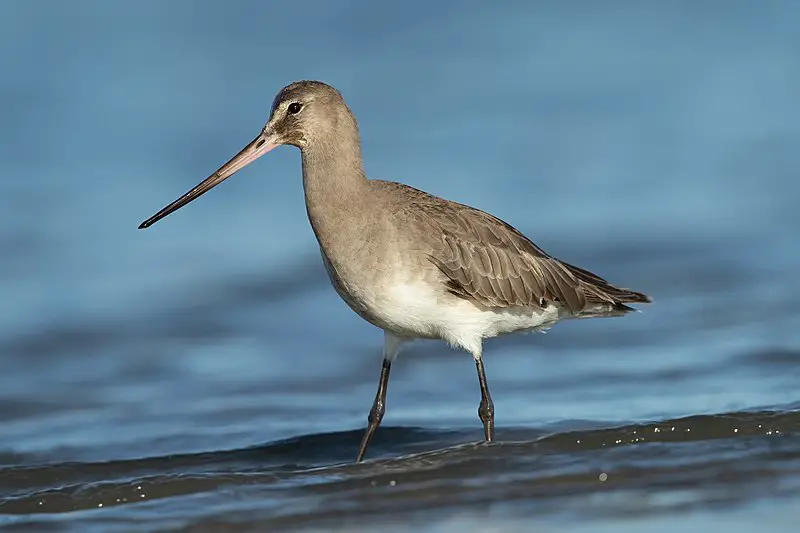
The Hudsonian godwit is a beautiful shorebird belonging to the sandpiper family. Its scientific name, Limosa haemastica, gives insight into its appearance; limus meaning muddy and haemastica translating to bloody in Ancient Greek – referring to its reddish-brown breast.
It was commonly referred to as red-breasted godwit in 18th century England. Godwit being an onomatopoeic term used for this bird since at least 1416–17.
The Hudsonian godwits migrate across many continents during breeding season – travelling over 16000 km between their Arctic breeding grounds and winter homes in South America or Africa.
They are incredibly resilient birds that have adapted well with changing environments throughout centuries while managing long migratory flights each year.
Scientific classification:
| Kingdom | Animalia |
| Phylum | Chordata |
| Class | Aves |
| Order | Charadriiformes |
| Family | Scolopacidae |
| Genus | Limosa |
| Species | L. haemastica |
Also Featured In: Common Northwest Territories Birds, Common Birds in Chiloé Island
26. Tapaculo
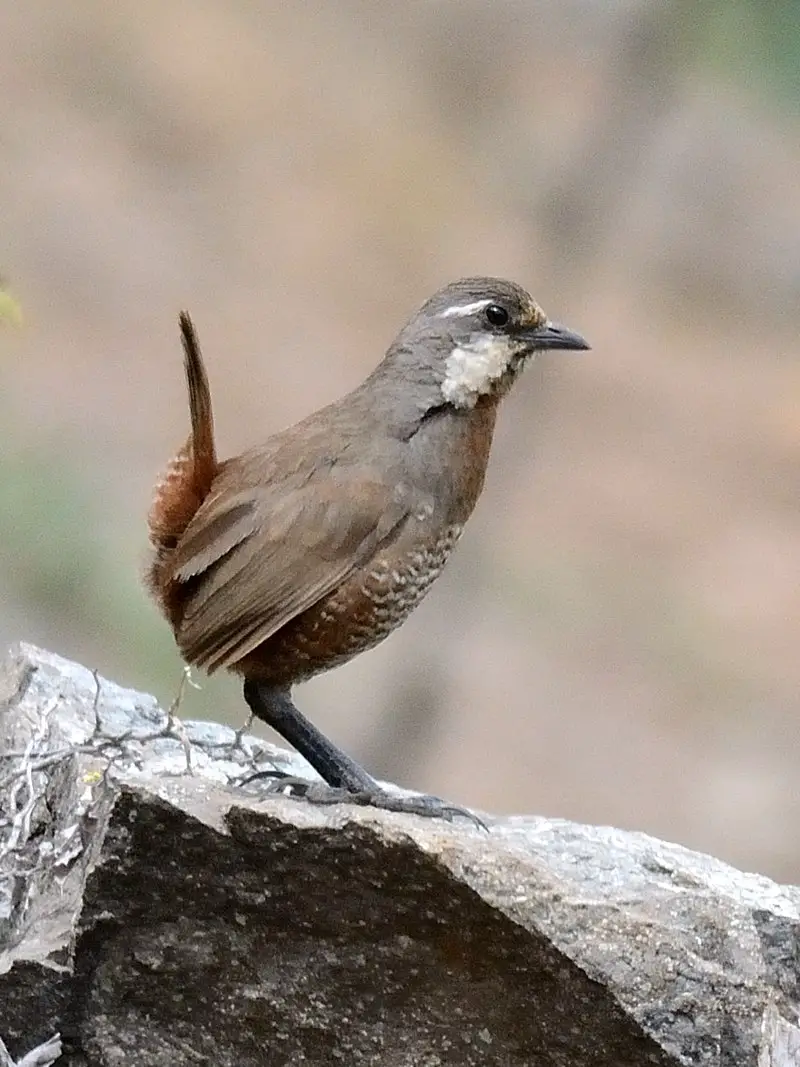
Tapaculos are a family of small to medium-sized, suboscine passerine birds found mainly in South America and parts of Central America. They range from 10-24 centimeters in length and have the highest diversity located within the Andean regions.
These birds typically have dark feathers on their head, back or wings with lighter colored bellies. Their habitat consists mostly of dense undergrowth near water sources such as streams or rivers where they can search for food amongst vegetation like insects and small rodents which make up most of their diet.
Tapaculos also build nests out of grasses, mosses, leaves and other natural materials to ensure protection from predators while breeding season is underway. With distinct calls that vary depending on species location; these unique creatures are not only an interesting sight but provide us with some beautiful sounds too.
Scientific classification:
| Kingdom | Animalia |
| Phylum | Chordata |
| Class | Aves |
| Order | Passeriformes |
| Superfamily | Formicaroidea |
| Family | Rhinocryptidae Wetmore, 1930 |
27. Black Vulture
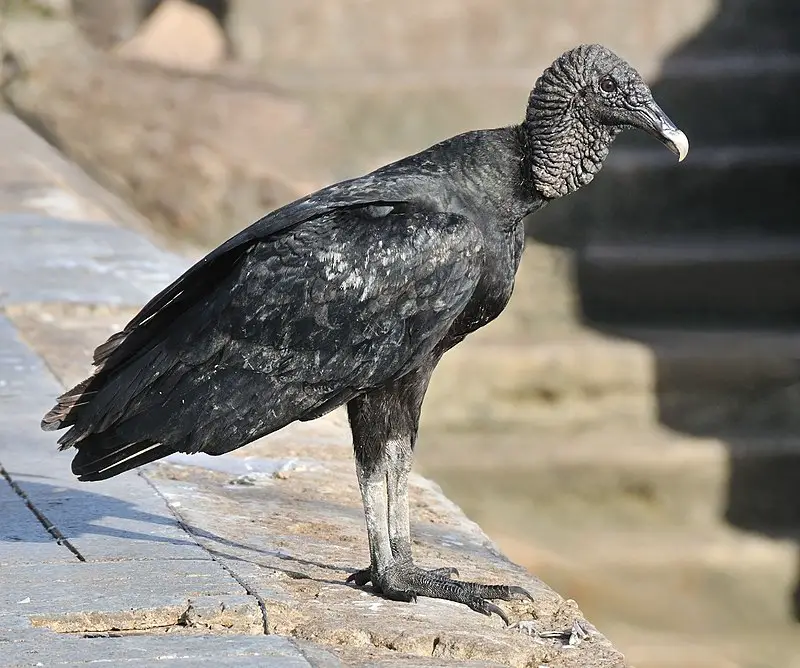
The black vulture is a common and widespread species of New World Vultures, found in the northeastern United States all the way to Peru, Central Chile and Uruguay.
It’s distinctive appearance has earned it many nicknames such as zopilote, urubu or gallinazo.
This medium-sized bird has mainly black plumage with some white markings on its wings and head; also featuring a long bill for scavenging carrion from carcasses.
Despite being able to fly up high due to its broad wingspan, it prefers keeping close to ground level when searching for food items like dead fish or small mammals that are available near human settlements.
As an apex predator they play an important role in nature by helping keep their environment clean while providing other animals with sustenance through their leftovers.
Scientific classification:
| Kingdom | Animalia |
| Phylum | Chordata |
| Class | Aves |
| Order | Accipitriformes |
| Family | Cathartidae |
| Genus | Coragyps |
| Species | C. atratus |
Also Featured In: Birds You’ll Find in Zoo, Birds that Live around Central Florida
28. Peruvian Thick-Knee
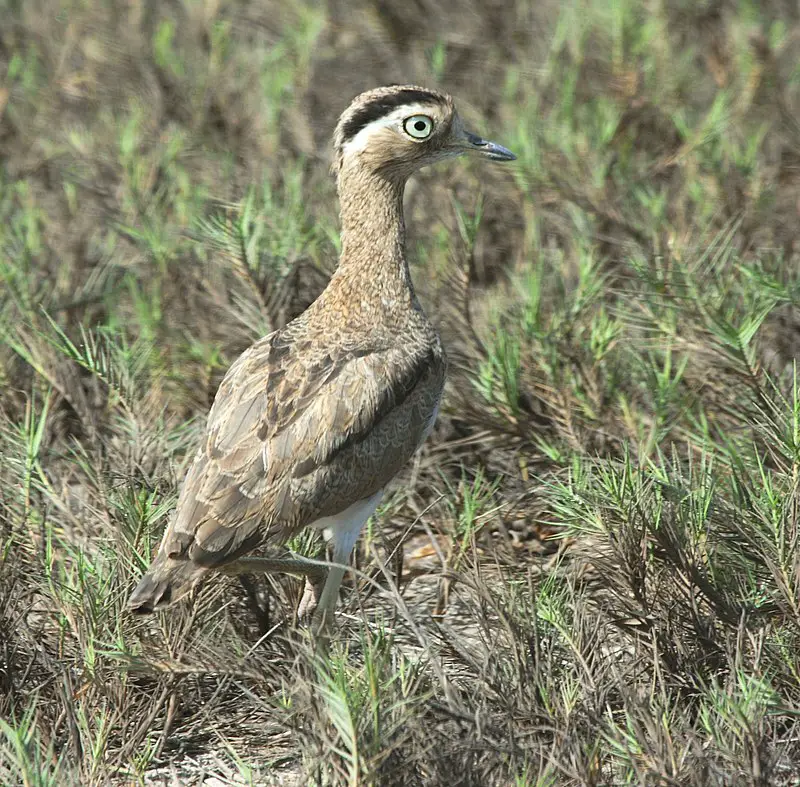
The Peruvian thick-knee is an impressive bird, belonging to the Burhinidae family. It has a unique appearance with its distinctive black and white plumage and striking yellow eyes.
This species can be found in Chile, Ecuador and Peru, where it inhabits dry shrublands, seasonally wet or flooded lowland grasslands and pasturelands. The Peruvian Thick-Knee is known as a ground dweller that feeds mainly on insects but also small animals like lizards or frogs if available.
It was formally described by French zoologist Charles Lucien Bonaparte in 1854 from specimens collected during his travels through South America; making this one of the oldest recognized birds native to these regions.
Scientific classification:
| Kingdom | Animalia |
| Phylum | Chordata |
| Class | Aves |
| Order | Charadriiformes |
| Family | Burhinidae |
| Genus | Burhinus |
| Species | B. superciliaris |
29. Chilean Mockingbird
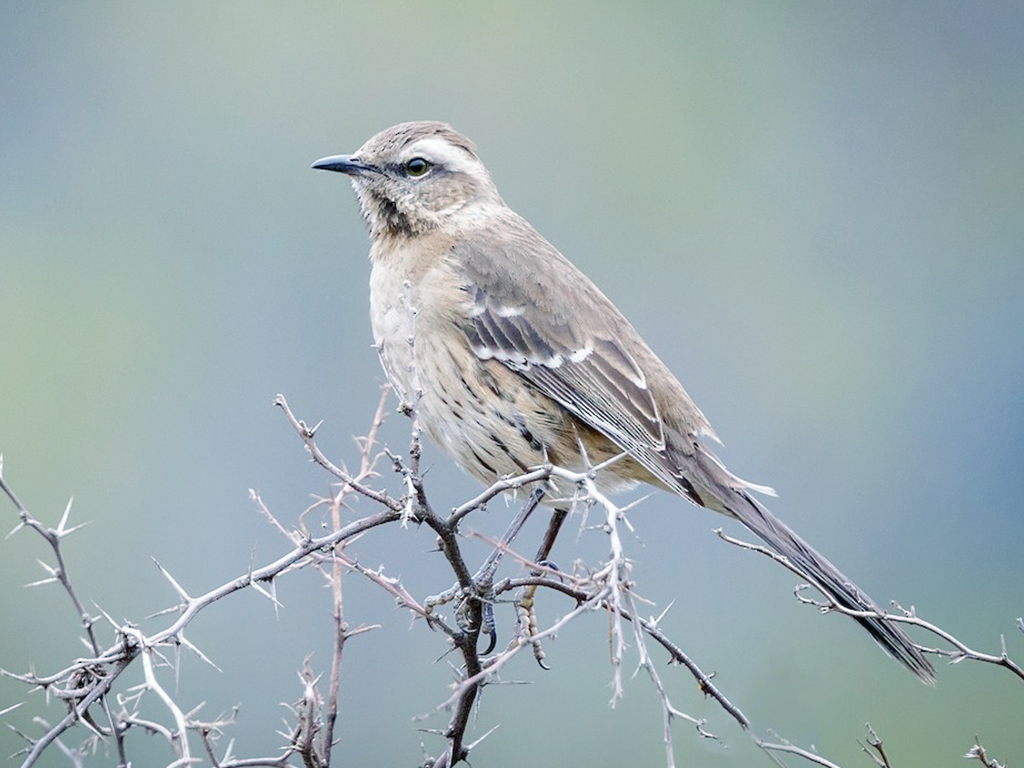
The Chilean Mockingbird, also known as Tenca, is a species of bird found in the family Mimidae. It is commonly seen inhabiting Chile’s northern half and there have been some reports of sightings in Argentina too.
This alluring creature has an average length between 28 to 29 cm and weighs around 66 grams. Males are usually larger than females when it comes to size differences.
Its plumage can be identified by its wide whitish supercilium above the eye area which goes down towards its neck along with a grey-brown backside dotted with white spots that further adds up to its beauty.
Scientific classification:
| Kingdom | Animalia |
| Phylum | Chordata |
| Class | Aves |
| Order | Passeriformes |
| Family | Mimidae |
| Genus | Mimus |
| Species | M. thenca |
30. Burrowing Owl
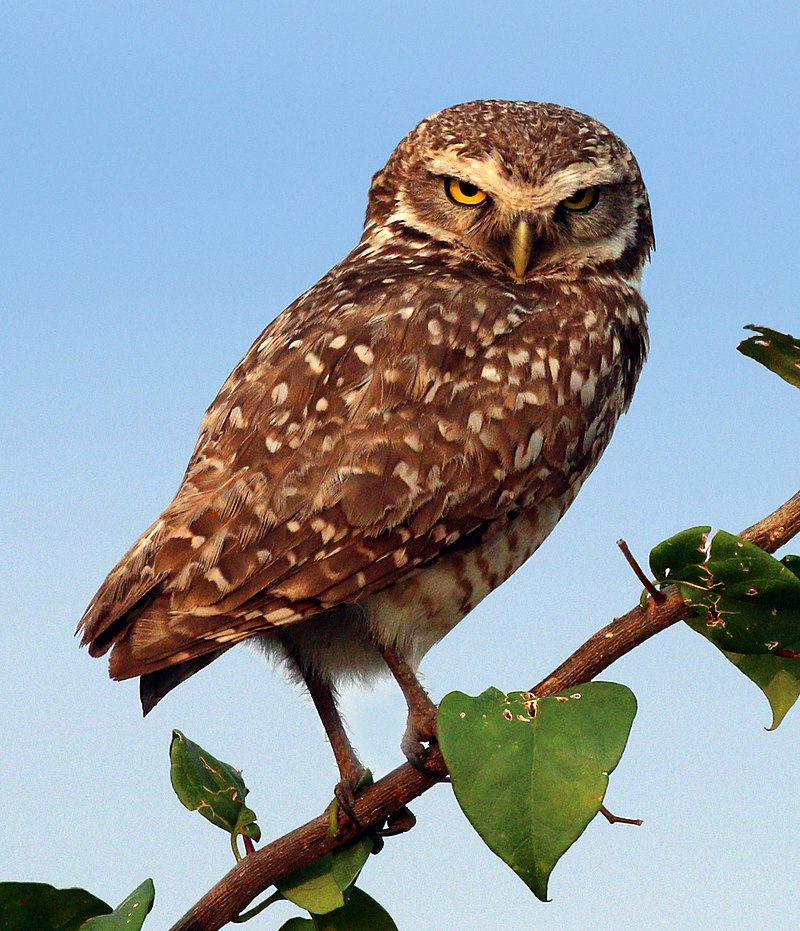
The Burrowing Owl is a small, long-legged owl found in open landscapes throughout North and South America. They are typically seen in grasslands, rangelands, agricultural areas or deserts with low vegetation.
Unlike most owls they nest and roost underground by taking over burrows made by other animals such as prairie dogs.
Their diet consists of insects, rodents and sometimes lizards or frogs that they hunt during the night time hours when their eyesight is sharpest.
This species faces threats due to habitat loss caused by human development but conservation efforts have been successful at reversing some of this damage allowing for populations to remain stable into the future despite these pressures.
Scientific classification:
| Kingdom | Animalia |
| Phylum | Chordata |
| Class | Aves |
| Order | Strigiformes |
| Family | Strigidae |
| Genus | Athene |
| Species | A. cunicularia |
31. Ringed Kingfisher
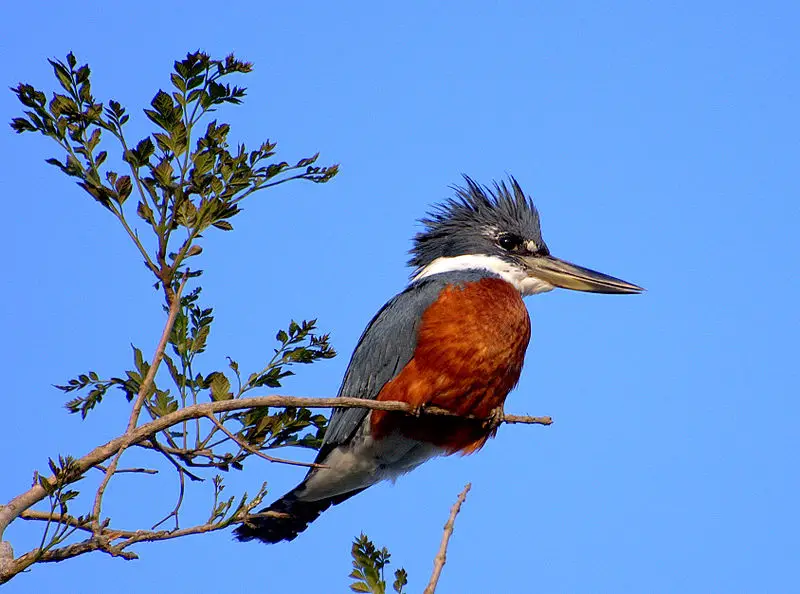
The Ringed Kingfisher is a large, vibrant bird that can be easily noticed by its loud call. It’s found in tropical regions from the lower Rio Grande Valley of southeastern Texas to Central America and even as far south as Tierra del Fuego.
This ground-dwelling species prefers to inhabit open areas near water bodies like streams, rivers and lakes which provide them with plenty of food such as fish, amphibians, crustaceans and insects.
In 1888 it was first identified by ornithologist Frank Chapman who noted its distinct ring pattern on the breast area.
The upperparts are dark blue while underneath they have white spots around their neck and belly region along with pale brown wings tipped in black stripes making this species quite unique among other kingfishers.
They may look intimidating but these birds actually play an important role for humans since they help control insect populations thus helping maintain a healthy balance within our ecosystems.
Scientific classification:
| Kingdom | Animalia |
| Phylum | Chordata |
| Class | Aves |
| Order | Coraciiformes |
| Family | Alcedinidae |
| Subfamily | Cerylinae |
| Genus | Megaceryle |
| Species | M. torquata |
32. Ornate Tinamou
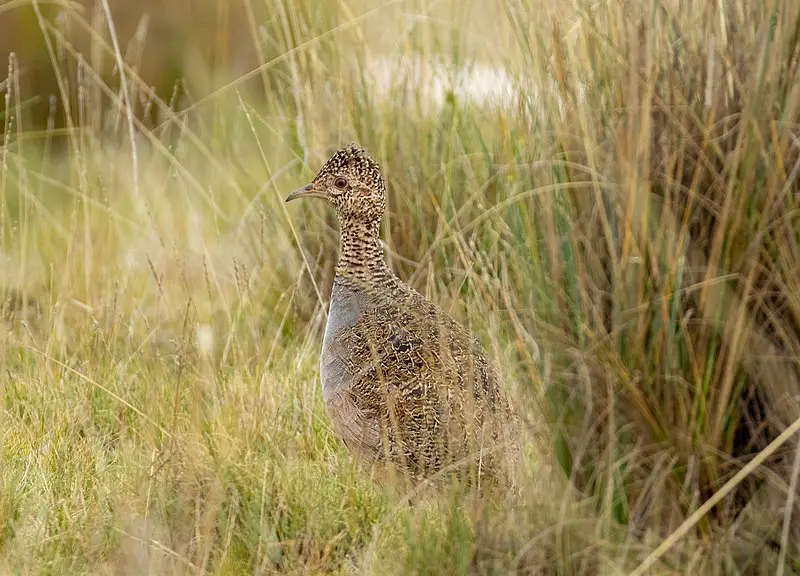
The Ornate Tinamou is a species of bird found in the subtropical and tropical regions of West Central South America. It inhabits high-altitude grasslands, dry shrubland and other habitats with open vegetation.
With its distinctive black-and-white plumage, long tail feathers, pointed bill and red eyes it easily stands out from its surroundings.
The Nothoprocta genus name comes from two Greek words meaning “spurious or counterfeit” and “hindpart or tail”, possibly referring to this bird’s hidden tail which can be hard to spot amongst the tall grasses it lives among.
This beautiful tinamou has been studied by experts for many years due to its interesting behaviour patterns as well as adaptations that enable them to survive in their natural environment.
Scientific classification:
| Kingdom | Animalia |
| Phylum | Chordata |
| Class | Aves |
| Infraclass | Palaeognathae |
| Order | Tinamiformes |
| Family | Tinamidae |
| Genus | Nothoprocta |
| Species | N. ornata |
33. Rufous-Legged Owl
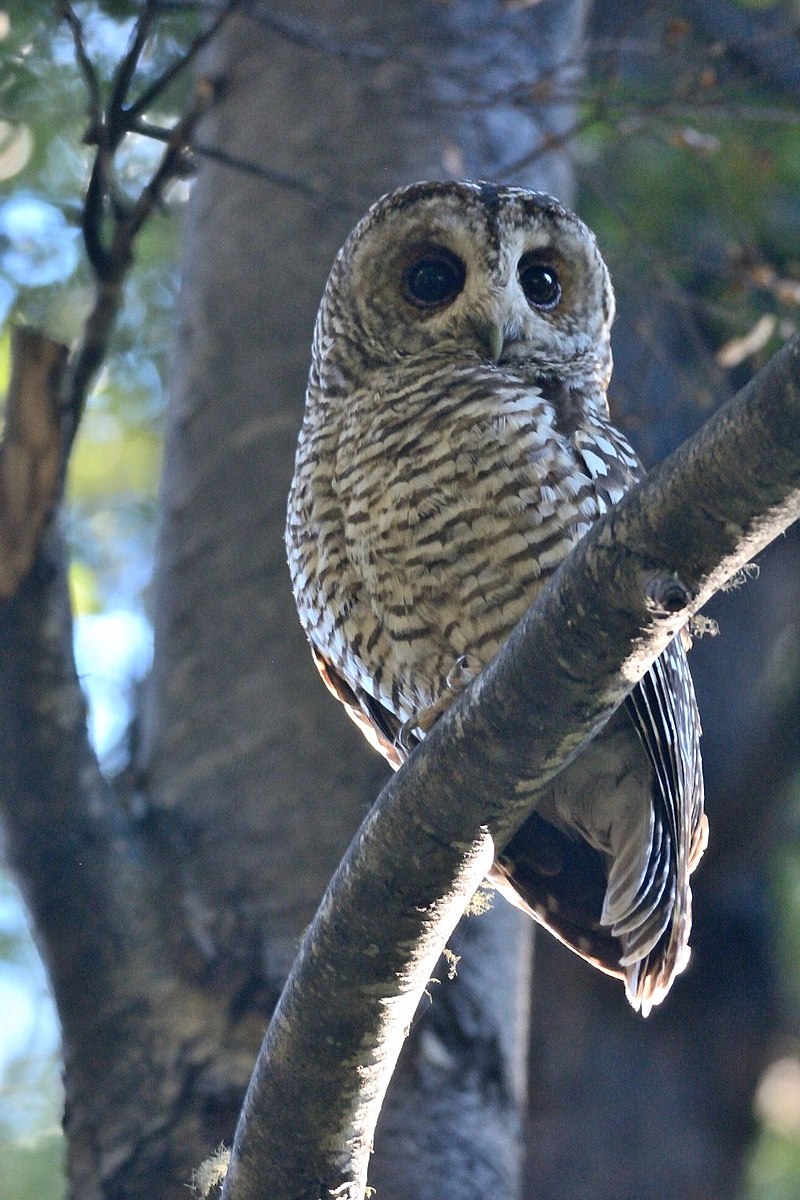
The Rufous-legged Owl is a medium sized bird found in Argentina and Chile. It has two subspecies, the nominate Strix rufipes rufipes and S. r. sanborni which was only identified from an immature specimen.
At one time it was believed to be part of the Chaco owl species but studies have since proven that there are distinct differences between them. They generally prefer open habitats such as shrublands or grassland where they can hunt for small mammals like mice, bats, lizards and insects during its nocturnal activities .
The males will establish their territories by calling out hoots making them easier to spot on moonlit nights . A unique feature of this species is its yellow eyes with black pupil surrounded by red rings around each eye giving it a fierce look while hunting at night.
Scientific classification:
| Kingdom | Animalia |
| Phylum | Chordata |
| Class | Aves |
| Order | Strigiformes |
| Family | Strigidae |
| Genus | Strix |
| Species | S. rufipes |
34. Mountain Parakeet
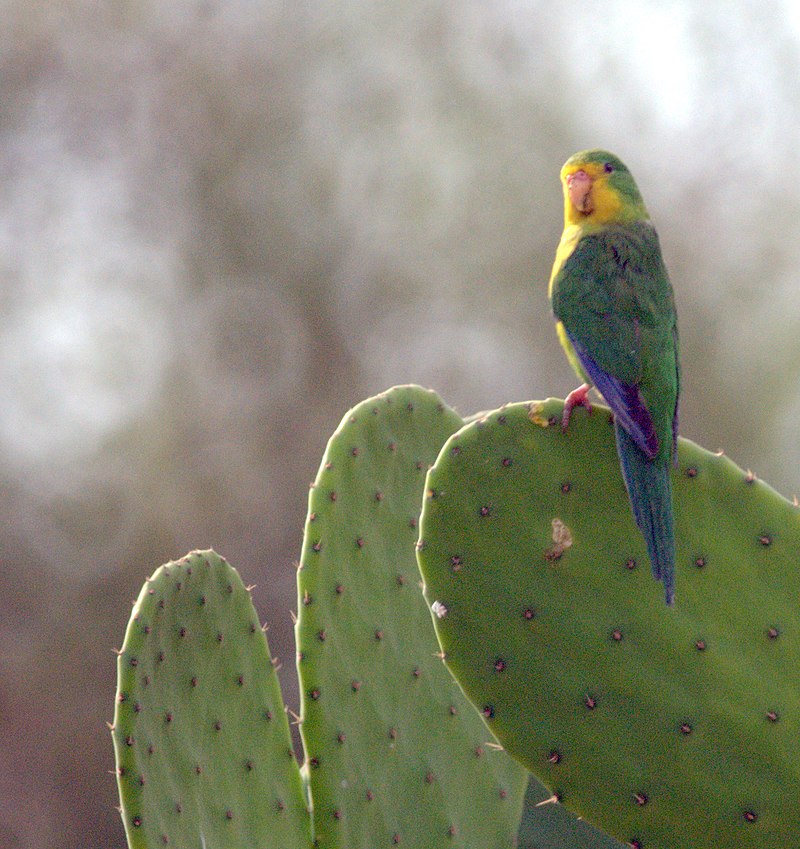
The Mountain parakeet, also known as the Golden-fronted Parakeet, is a species of small parrot found in Puna grasslands. It has four recognized subspecies with an average length of 18 cm (7in).
This bird’s natural habitat is subtropical or tropical high-altitude shrubland and it can be identified by its bright yellow forehead feathers and long blue tail. Its wings are greenish on top while underneath they appear greyish white; its chest is pale green and its lower body brownish-green streaked with black barring.
The mountain parakeet mainly feeds on fruits, buds, nuts but can also eat insects like beetles larvae when available. They usually inhabit flocks ranging from 5 to 30 individuals during their daily activities such as looking for food or nesting sites that consists mostly of cavities in dead trees near water sources.
Despite being a lesser known species due to its remote location the golden fronted parakeets have been thriving for many years.
Scientific classification:
| Kingdom | Animalia |
| Phylum | Chordata |
| Class | Aves |
| Order | Psittaciformes |
| Family | Psittacidae |
| Genus | Psilopsiagon |
| Species | P. aurifrons |
35. Croaking Ground Dove
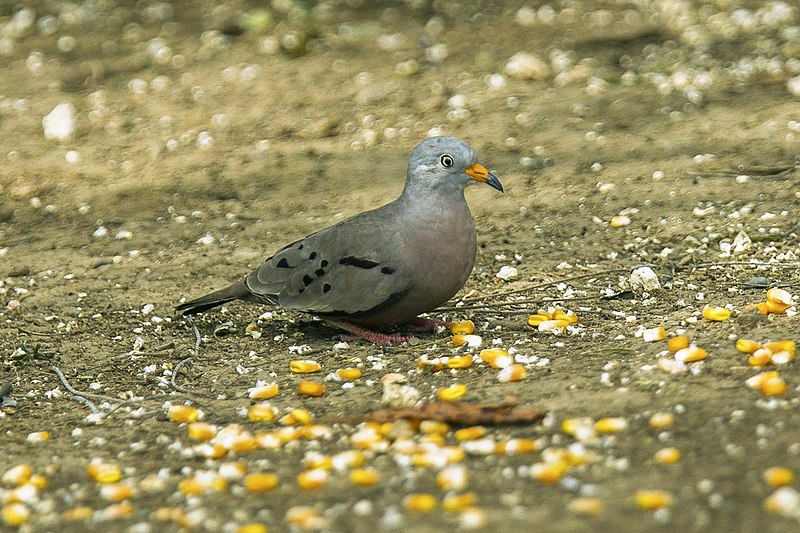
The Croaking Ground Dove is a medium-sized bird found in South America, inhabiting countries such as Chile, Colombia, Ecuador and Peru. It has been suggested that it is closely related to the Picui ground dove.
The adult males are around 15 cm long and weigh an average of 52 g while females measure slightly less at 46g. They have distinctive yellow eyes with white feathers on their face which gives them quite a unique look.
Their diet consists mainly of seeds foraged from grasslands or near water sources like rivers and streams; however they may supplement this with insects too when available. Overall these birds make excellent additions to any wild garden – providing plenty of colour and activity all year round.
Scientific classification:
| Kingdom | Animalia |
| Phylum | Chordata |
| Class | Aves |
| Order | Columbiformes |
| Family | Columbidae |
| Genus | Columbina |
| Species | C. cruziana |
36. Andean Flicker
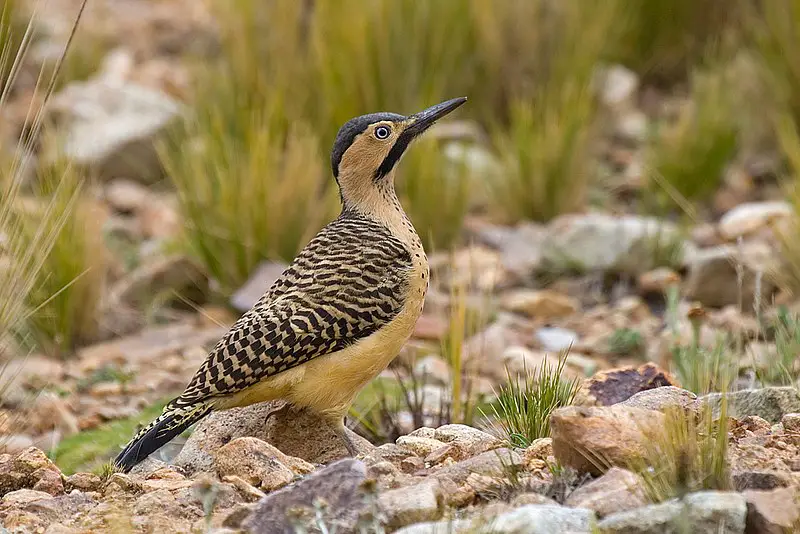
The Andean Flicker is a South American species of woodpecker, found in grasslands and shrublands at altitudes between 2,000-5,000 metres.
It stands out amongst other woodpeckers due to its largely terrestrial lifestyle.
This large bird has an impressive length of 32 cm and features reddish brown upperparts with white underparts.
Its face bears a distinctive black moustache mark on each side which gives it an iconic look.
The inner wings are yellow or orangey red whereas the outer ones are barred greyish white and chestnut colouring can be seen around the neck region.
They have long bills for probing into deep crevices when searching for food such as insects, grubs and small reptiles or amphibians that live beneath tree bark or soil surfaces near streams or rivers etcetera.
Their loud calls are often heard throughout their natural range during breeding season from September – November .
Scientific classification:
| Kingdom | Animalia |
| Phylum | Chordata |
| Class | Aves |
| Order | Piciformes |
| Family | Picidae |
| Genus | Colaptes |
| Species | C. rupicola |
37. Green Kingfisher
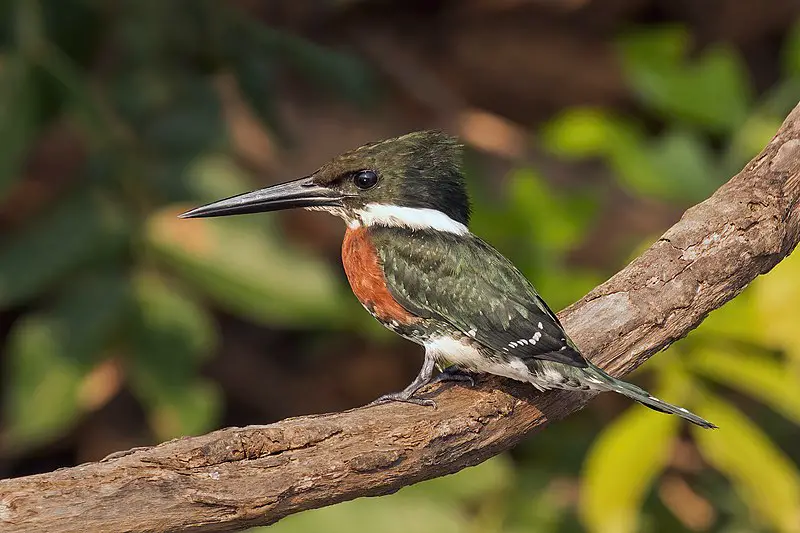
The Green Kingfisher is an incredibly vibrant bird, boasting a bright green plumage and long beak.
It can primarily be found throughout Central America, in most South American countries except Chile, as well as Texas in the United States and Trinidad & Tobago.
This species of water kingfisher belongs to subfamily Cerylinaeof family Alcedinidae which was first described by German naturalist Johann Friedrich Gmeiner back in 1788.
The Green Kingfishers are known for their active hunting habits where they perch above shallow waters looking out for prey such as small fish or crustaceans before diving down rapidly into the water with a loud splash.
Scientific classification:
| Kingdom | Animalia |
| Phylum | Chordata |
| Class | Aves |
| Order | Coraciiformes |
| Family | Alcedinidae |
| Subfamily | Cerylinae |
| Genus | Chloroceryle |
| Species | C. americana |
Also Featured In: Birds You’ll Find in South Texas , Birds You’ll Find in the Rio Grande Valley
38. Puna Tinamou
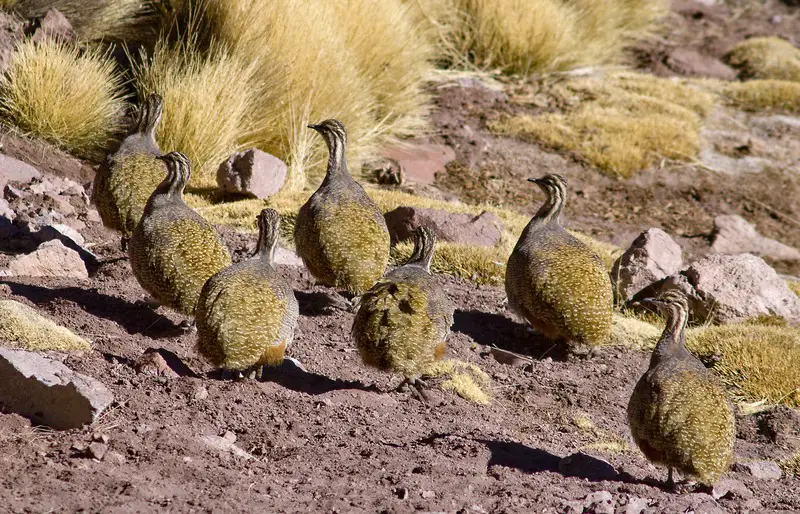
The Puna Tinamou is an ancient bird species native to southern South America. It has a dark brown body, bright yellow legs and beak, and white spots on its wings.
Its binomial name (Tinamotis pentlandii) was given in honor of Joseph Barclay Pentland by Nicholas Aylward Vigors in 1837. The IUCN lists them as least concern due to their wide range and population stability although it does face some threats from hunting for meat or feathers, habitat loss due to agriculture expansion, changes in land use practices such as burning of grasslands which affects the availability of food sources.
Conservation efforts are being put forward such as creating protected areas but more work needs to be done if we want future generations to enjoy these wonderful birds.
Scientific classification:
| Kingdom | Animalia |
| Phylum | Chordata |
| Class | Aves |
| Infraclass | Palaeognathae |
| Order | Tinamiformes |
| Family | Tinamidae |
| Genus | Tinamotis |
| Species | T. pentlandii |
39. Elegant Crested Tinamou
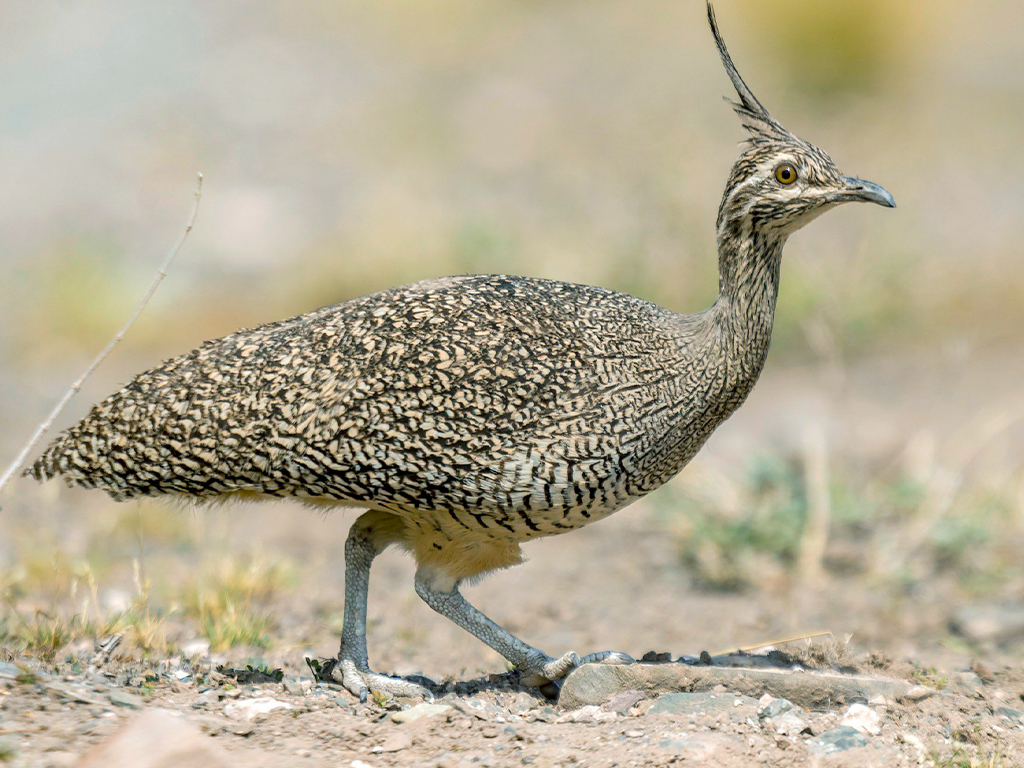
The elegant crested tinamou, or martineta tinamou (Eudromia elegans), is a medium-sized bird found in southern Chile and Argentina. This species has an omnivorous diet and is often seen on the ground due to its poor flying ability.
It has rounded wings that give it a partridge-like shape, with olive brown plumage being the main coloration of this bird.
Its most distinct feature however is its crest which gives it both elegance and distinction amongst other members of its family.
The populations for these birds have been slowly declining over time due to human activity such as habitat destruction but conservation efforts are underway in order to protect them from further decline.
Scientific classification:
| Kingdom | Animalia |
| Phylum | Chordata |
| Class | Aves |
| Infraclass | Palaeognathae |
| Order | Tinamiformes |
| Family | Tinamidae |
| Genus | Eudromia |
| Species | E. elegans |
40. Tyrant Flycatchers
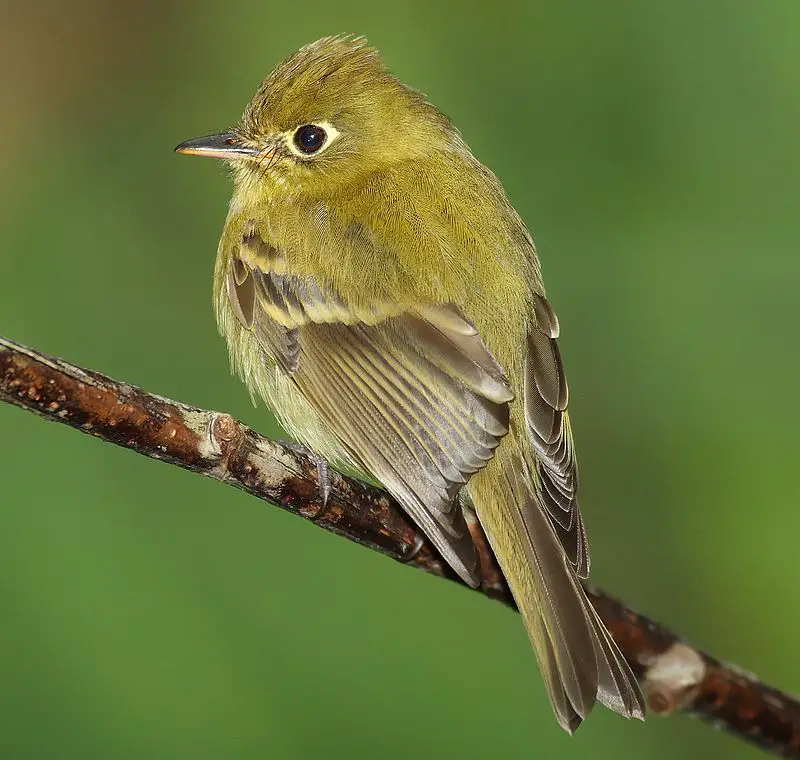
Tyrant flycatchers are a family of birds found in North and South America, containing over 400 species. These birds come in an array of shapes and sizes, with vibrant plumage to match.
They�re the most diverse avian family across all countries they inhabit except for the United States and Canada.
Their diet consists mainly of insects but also includes small reptiles or amphibians where available.
The behavior varies between each bird; some prefer open areas while others like dense forests as their habitat � many even migrate regularly.
Tyrant Flycatchers have adapted well to human presence thanks to the abundance of food sources that often accompany it � such as backyards, parks etc..
All things considered these incredible creatures are truly amazing.
Scientific classification:
| Kingdom | Animalia |
| Phylum | Chordata |
| Class | Aves |
| Order | Passeriformes |
| Parvorder | Tyrannida |
| Family | Tyrannidae Vigors, 1825 |
41. Torrent Duck
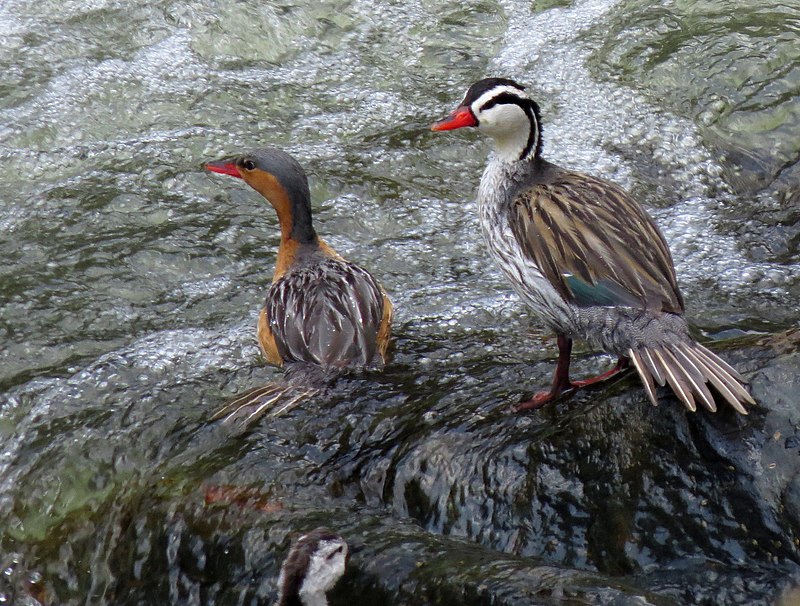
The Torrent Duck is a beautiful member of the duck, goose and swan family Anatidae. It is found in mountainous regions throughout South America and measures 43-46 centimetres long.
This unique species has its own genus – Merganetta armata – which belongs to the shelduck subfamily Tadorninae.
Its striking plumage includes dark brown feathers with varying shades from black to white on their wings, back and head as well as having yellow legs and feet.
They are mostly seen around fast flowing streams or small rivers where they feed mainly on aquatic invertebrates such as shrimp, insects, worms etc., but occasionally also take some plant material too.
These birds live in pairs for most of the year although during breeding season they may form larger groups or flocks when looking for food resources together.
Scientific classification:
| Kingdom | Animalia |
| Phylum | Chordata |
| Class | Aves |
| Order | Anseriformes |
| Family | Anatidae |
| Genus | Merganetta Gould, 1842 |
| Species | M. armata |
42. Upland Goose
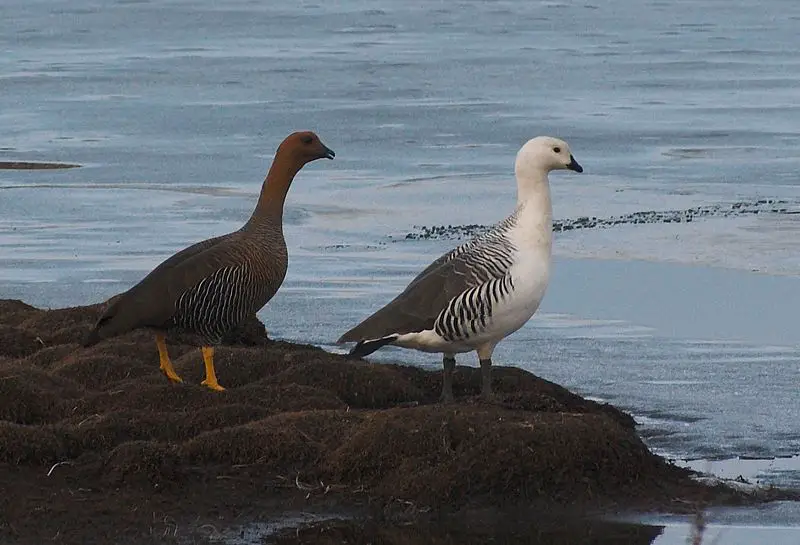
The Upland Goose, also known as the Magellan Goose, is a species of sheldgoose belonging to the Anatidae family.
With its similar habits and appearance to true geese, this bird has two recognized subspecies – Chloephaga picta leucoptera and C. p. picta which inhabit regions in South America such as Patagonia and Tierra del Fuego respectively.
They are highly sociable birds that live in small flocks or pairs on open grassland with access to water sources for bathing and twilight feedings when they hunt for food items like insects, worms or molluscs.
Their feathers range from brownish grey colours along their wings while white underparts give them an overall spotted effect making these birds very attractive creatures.
Scientific classification:
| Kingdom | Animalia |
| Phylum | Chordata |
| Class | Aves |
| Order | Anseriformes |
| Family | Anatidae |
| Genus | Chloephaga |
| Species | C. picta |
Also Featured In: Falkland Islands Birds You Need To Know, Birds That Live around East Falkland
43. Great Grebe
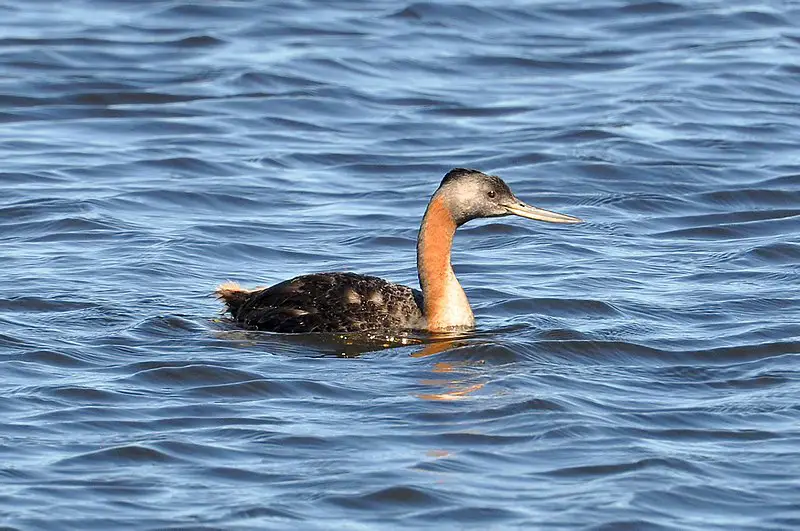
The Great Grebe is a majestic bird that stands out from other species of grebes thanks to its size. It has an extensive range, stretching across extreme southeastern Brazil all the way down to central Chile and Patagonia.
A distinct subspecies of this species can be found in southern Chile, known as P. m. navasi.
This remarkable creature was first described by French polymath Georges-Louis Leclerc, Comte de Buffon in 1781 who marvelled at it’s unique features such as its long slender neck and heavy bill which make it stand out among waterfowls around the world today.
Scientific classification:
| Kingdom | Animalia |
| Phylum | Chordata |
| Class | Aves |
| Order | Podicipediformes |
| Family | Podicipedidae |
| Genus | Podiceps |
| Species | P. major |
44. Fire-Eyed Diucon
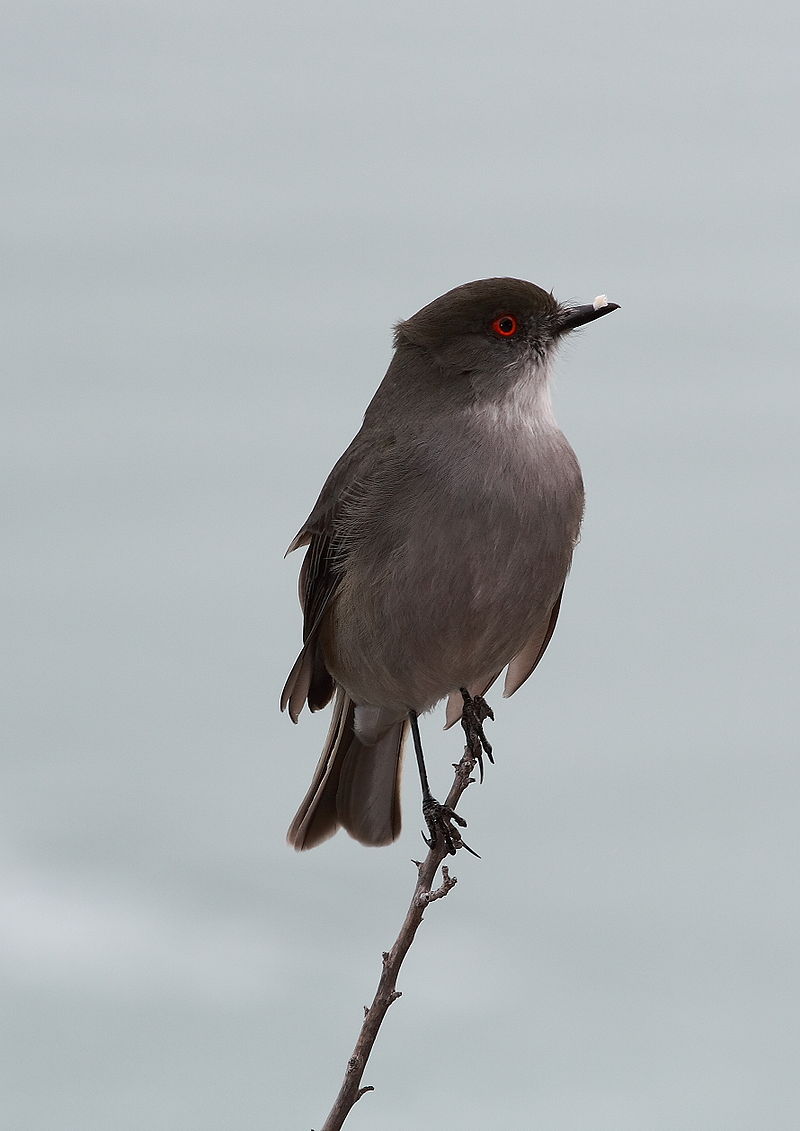
The Fire-eyed Diucon is a unique species of passerine bird belonging to the Tyrannidae family, found in Central and South America.
It has an impressive 19–21 cm length with grey upperparts and pale grey underparts with white throat and undertail coverts.
Its most distinct feature is its bright coral-red eyes, for which it was named after. The diucon also makes distinctive call sounds like ‘tche’ or ‘dzee’ that can be heard during all times of day as well as night, often repeated several times over in succession.
This beautiful creature lives mainly on insects but will sometimes make use of fruits when other food sources are scarce.
They prefer open areas such as shrubby hillsides and woodlands where they find plenty of their favourite snacks.
Scientific classification:
| Kingdom | Animalia |
| Phylum | Chordata |
| Class | Aves |
| Order | Passeriformes |
| Family | Tyrannidae |
| Genus | Pyrope Cabanis & Heine, 1860 |
| Species | P. pyrope |
45. Grey-Flanked Cinclodes
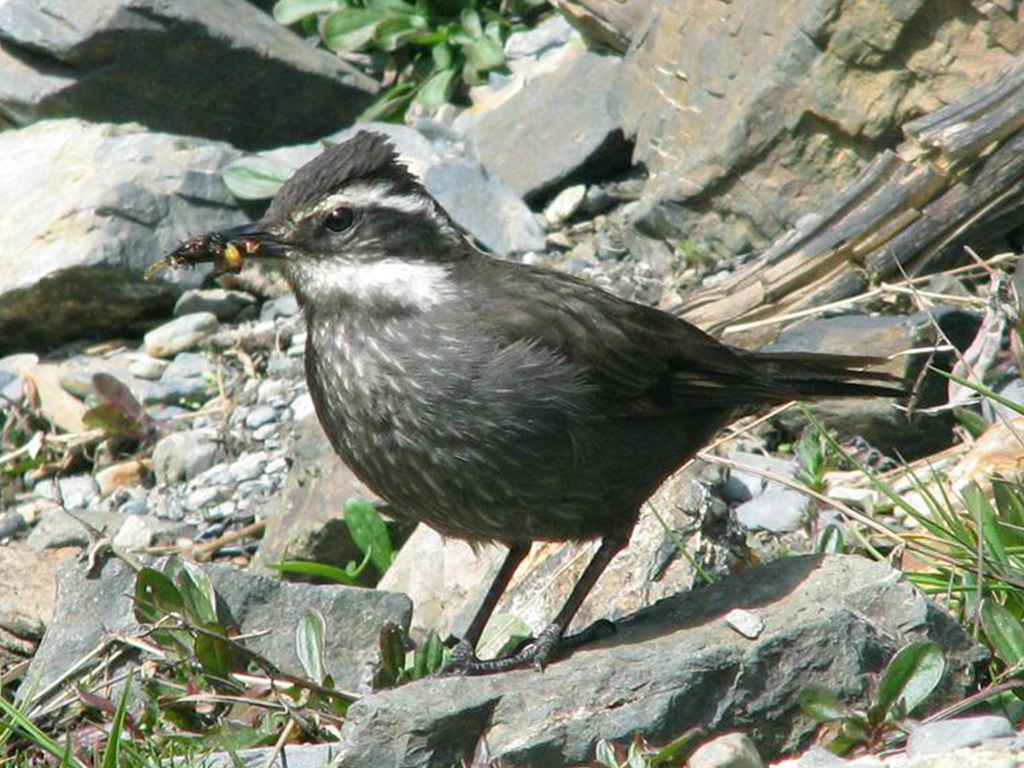
The Grey-flanked Cinclodes is a species of bird found in Chile, Argentina and Tierra del Fuego. It inhabits subtropical or tropical dry shrubland and high altitude shrubland.
Its plumage is greyish brown with rufous crown and wings, white supercilium and cinnamon streaked underparts.
This small passerine feeds on insects that it finds amongst the ground vegetation as well as seeds from plants like grasses, sedges and herbs.
Breeding season occurs between October to December during which they build nests made up of sticks lined inside with soft material such mosses or feathers near streams among rocks.
Sadly this species has been classified vulnerable due to destruction of its natural habitats by humans for agriculture purposes.
Scientific classification:
| Kingdom | Animalia |
| Phylum | Chordata |
| Class | Aves |
| Order | Passeriformes |
| Family | Furnariidae |
| Genus | Cinclodes |
| Species | C. oustaleti |
46. Creamy-Rumped Miner
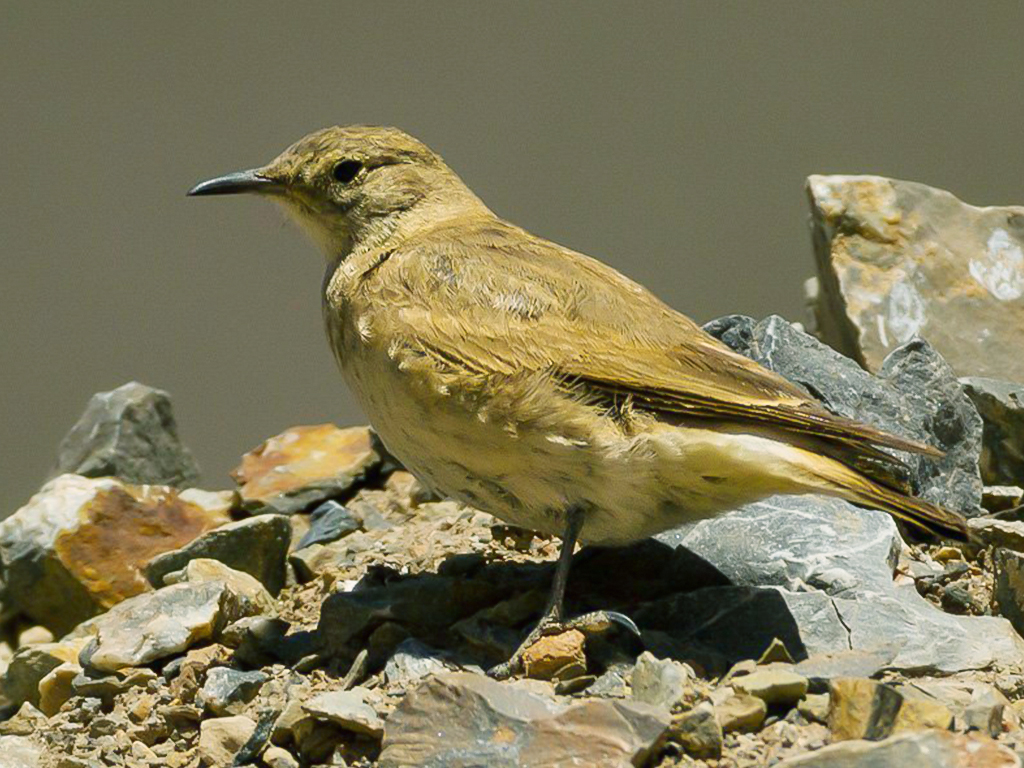
The Creamy-rumped Miner is a species of bird belonging to the Furnariidae family. It can be found in Argentina and Chile, where it inhabits subtropical or tropical high-altitude grasslands.
This small songbird has an olive brown upper body, rufous wings with white spots on its primaries, and pale yellow underparts that are tinged in creamy buff coloration. Its tail is dark greyish with white edges and two central feathers tipped in black.
They feed mainly on insects but also consume seeds occasionally when available during cold months of the year; this behavior makes them an important seed dispersal agent for native plants as well as agricultural crops such as wheat grains.
The population size remains stable since they do not face any major threats at present time however extensive agriculture may reduce their habitat causing potential issues for long term survival if conservation plans are not implemented soon enough.
Scientific classification:
| Kingdom | Animalia |
| Phylum | Chordata |
| Class | Aves |
| Order | Passeriformes |
| Family | Furnariidae |
| Genus | Geositta |
| Species | G. isabellina |
47. Greyish Miner
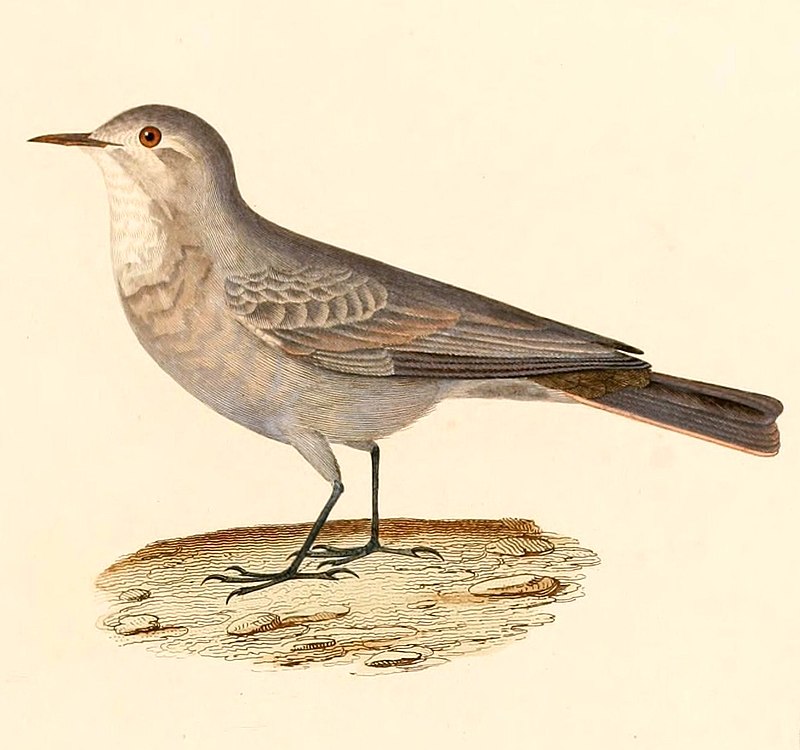
The Greyish Miner is a species of bird belonging to the Furnariidae family. It is found in Chile and Peru, typically inhabiting dry shrubland environments.
They are small birds with grey-brown plumage on their upperparts, paler stripes above the eyes and white underparts that contrast with darker streaks along its flanks.
Their wings are short but broad which allows them to maneuver quickly through dense vegetation or over rocky terrain when foraging for food like insects and spiders among rocks or low bushes.
The Greyish Miner has been listed as Least Concern by IUCN due to its wide distribution range and stable population numbers throughout most of its range despite some localized declines due to habitat destruction from agriculture expansion.
Scientific classification:
| Kingdom | Animalia |
| Phylum | Chordata |
| Class | Aves |
| Order | Passeriformes |
| Family | Furnariidae |
| Genus | Geositta |
| Species | G. maritima |
48. Southern Giant Petrel
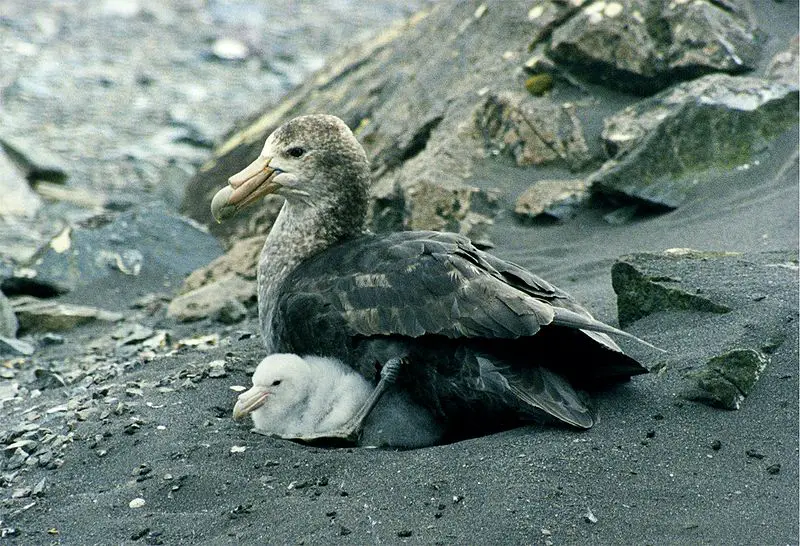
The Southern giant petrel is a large seabird native to the southern oceans, and it overlaps broadly with its similar counterpart, the Northern giant petrel.
Adults of both species can be distinguished by their bill-tip color: greenish in the south and yellowish in the north.
The Southern giant petrel also goes by other names such as Antarctic giant petrel, Giant fulmar, Stinker or Stinkpot.
These birds are around 75 cm (30 inches) long on average and have striking white plumage combined with brown wings that give them an impressive appearance while they soar through skies above open waters searching for food like fish, krill and squid – which they can catch up to 100 meters below sea level.
Scientific classification:
| Kingdom | Animalia |
| Phylum | Chordata |
| Class | Aves |
| Order | Procellariiformes |
| Family | Procellariidae |
| Genus | Macronectes |
| Species | M. giganteus |
49. Peruvian Pelican
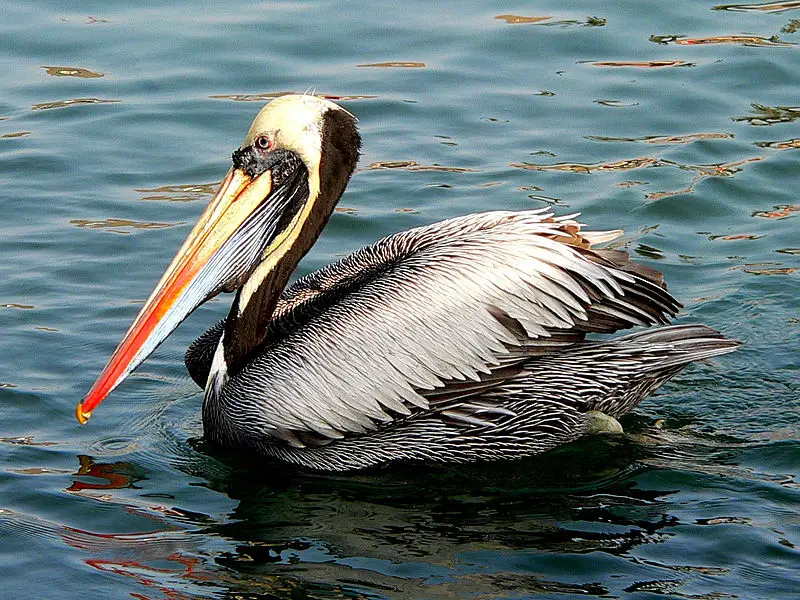
The Peruvian Pelican is a beautiful species of bird native to the western coast of South America. They have dark plumage with a distinctive white stripe that runs from their bill up to the crown and down both sides of their neck.
These majestic birds can be found in Chile, Peru, Ecuador and sometimes even further south.
They live in colonies near coastal areas where they feed on fish which they catch by diving into the water or scooping them up off the surface using their large bills.
The population is thought to be decreasing due to overfishing, pollution as well as habitat destruction caused by human activities like mining, construction and agricultural development.
Conservation efforts are needed if we want these magnificent animals around for future generations.
Scientific classification:
| Kingdom | Animalia |
| Phylum | Chordata |
| Class | Aves |
| Order | Pelecaniformes |
| Family | Pelecanidae |
| Genus | Pelecanus |
| Species | P. thagus |